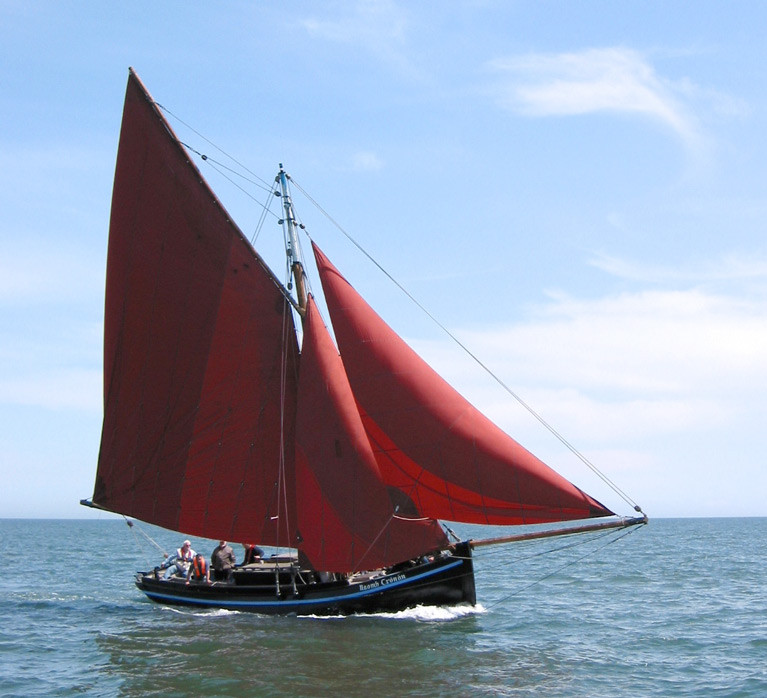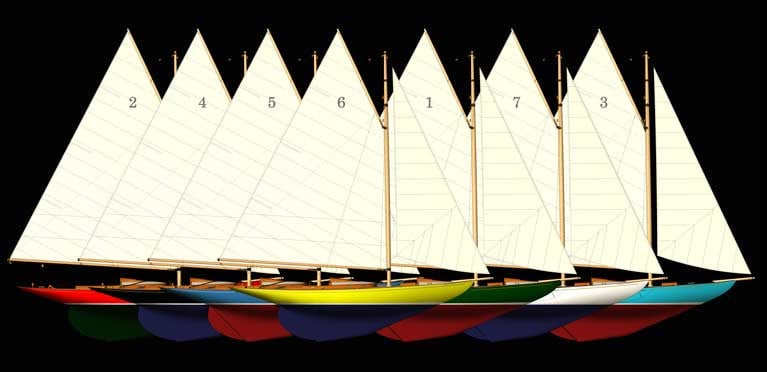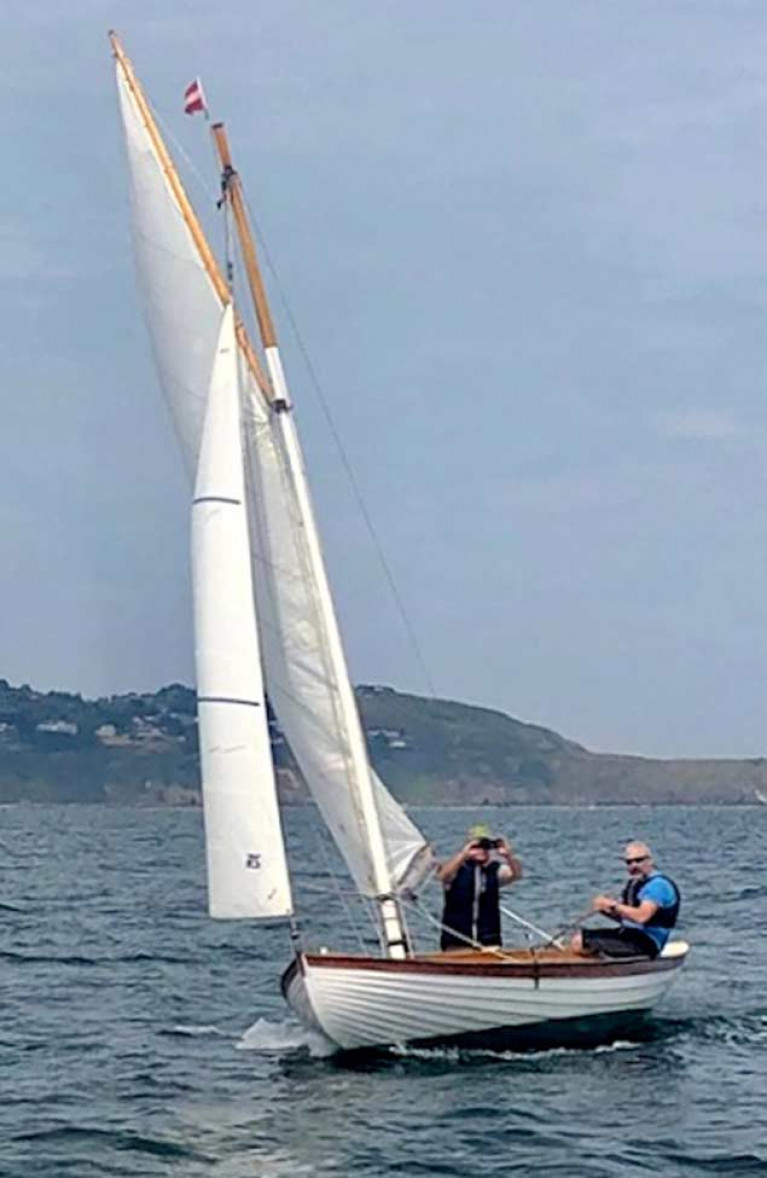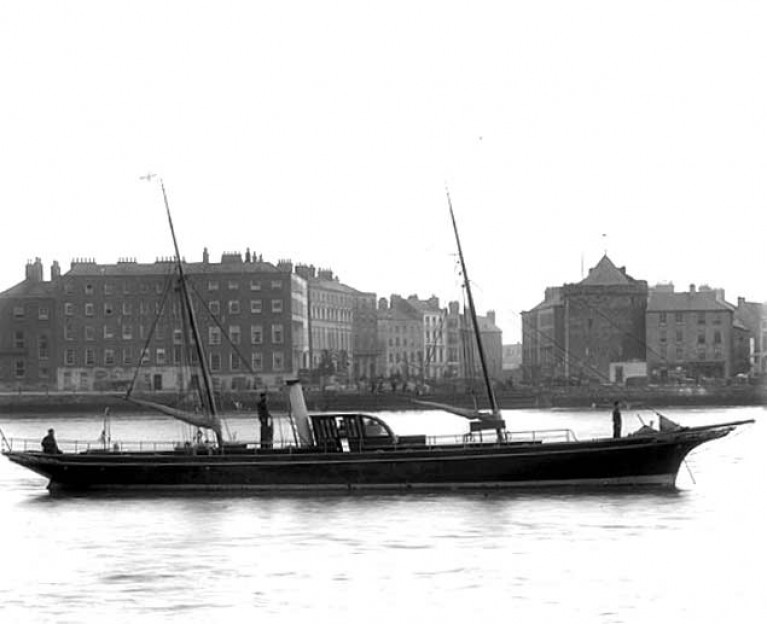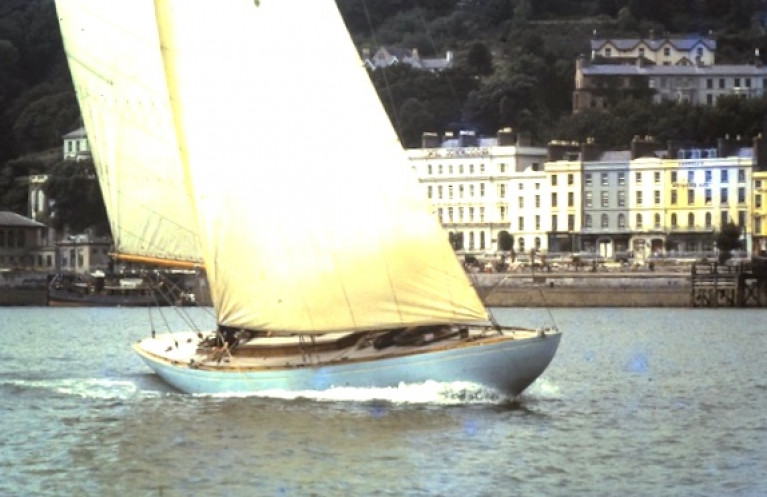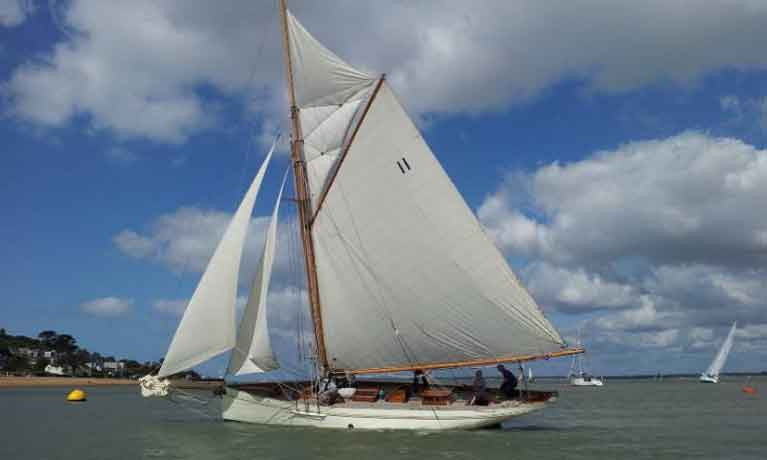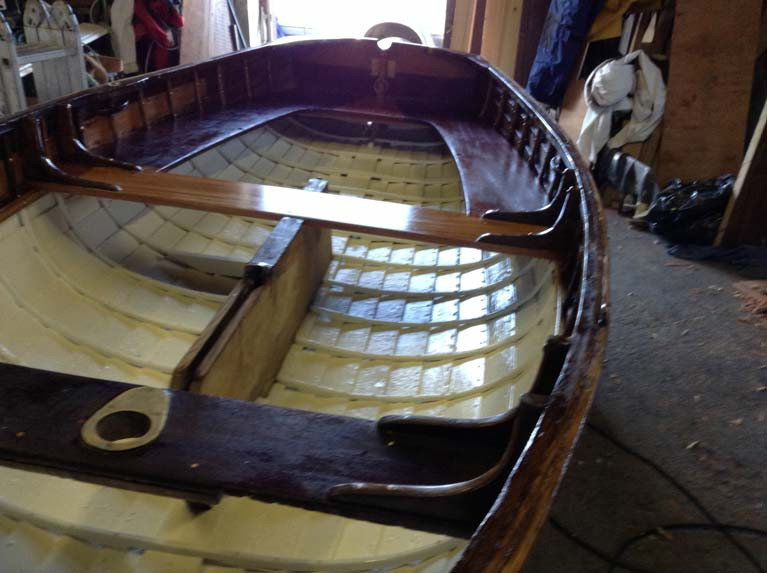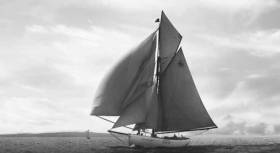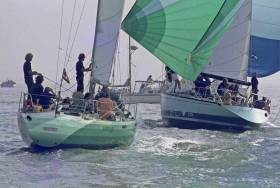Displaying items by tag: Historic Boats
If you’re having trouble processing the full implications of the fascinating new portmanteau ministry which has emerged this week from the formation of our latest government, not to worry. You’d be on your own if you weren’t a little bit bewildered. But as it happens, sailing folk can be of good cheer. When we look at it calmly, there’s good reason to believe that it was all put together in order to meet the needs and achievements of one of the best-known boats in Ireland, the Clondalkin community-built 43ft Galway hooker Naomh Cronan, a classic bad mor or big boat.
Naomh Cronan is in the news this week in any case. After 23 years of great sailing, good racing and some impressive voyaging from Poolbeg in Dublin Port, it’s the end of an era. She has joined the western trek of traditional craft, and is now within the remit of Badoiri an Cladaig, - the Claddagh Boatmen - in their traditional base at the mouth of the River Corrib in the heart of Galway City.
In that picturesque harbour, there used to be a huge fleet of traditional tanned-sail craft at a time when Clondalkin was still mostly just fine farming country, the only nautical connection being the Grand Canal heading west through meadowland from Dublin Bay towards the River Barrow and the lordly Shannon.
 Traditional sail at The Claddagh, home of Badoiri an Cladaigh. This is Ross Forde’s 25ft gleoiteog mor Lady Anne of 1882 vintage sailing into the Corrib - she is used by the Galway Hooker Sailing Club as a sail training vessel
Traditional sail at The Claddagh, home of Badoiri an Cladaigh. This is Ross Forde’s 25ft gleoiteog mor Lady Anne of 1882 vintage sailing into the Corrib - she is used by the Galway Hooker Sailing Club as a sail training vessel
So that’s fine and dandy, say you, but what’s this about the new do-everything Department apparently being specifically assembled to meet the historical and present and future needs of the Naomh Cronan? Well, it’s all here in the fresh-minted Department’s title. And we ask our many overseas readers to bear with us, but this really is the name of the Hydra-headed administrative machine which has emerged from the undergrowth of political backroom wheeler-dealing in recent days.
It’s called the Department of Media, Tourism, Arts, Culture, Sport and The Gaeltacht. Seriously. In one of the most sports-mad nations on earth, the greatest passion of the majority of the population seems to be ranked fifth in priority in a wide selection of interests and specialities each of which might well - in a more detailed society - be worth a Department of its own, though we would concede that maybe Arts & Culture might go together in one.
 Carrying the message – Naomh Cronan at Portaferry for the Sails & Sounds Festival
Carrying the message – Naomh Cronan at Portaferry for the Sails & Sounds Festival New waters – Naomh Cronan on Strangford Lough
New waters – Naomh Cronan on Strangford Lough
But in any case, all is not as it initially seemed a few days ago, when the new setup was first announced. For as it happens, it may actually be three Departments in one. When the new conglomerate was revealed at the beginning of the week, it had just one Minister, who is a senior member of the Cabinet. But when the supporting Ministers of State were announced later in the week, two of them were allocated areas of interest across the new Department, which made it a much more positive and potentially productive arrangement.
But how on earth is it that this complex new multi-functional department seems to have been created precisely with the story of the Naomh Cronan in mind? Let us count the ways:
MEDIA: Check. Ever since her construction started as a project inaugurated by Muintir Chronain under the auspices of Aras Chronain Ionad Cultuir (the Irish Cultural Centre in Clondalkin, West Dublin) all of 27 years ago, Naomh Cronan has been an item of media interest ashore and afloat, her creation and vibrant existence being of interest both in themselves, and as an exercise for trainee communicators and other media wannabees.
TOURISM: Check. The evocative dark and distinctive sails of the Galway hookers slipping through the myriad waterways of Connemara and Galway Bay may be the ultimate iconic and eternally-remembered vision for visitors to the west - to l’Irelande profonde - yet from her East Coast base of 23 years, the Naomh Cronan has managed to become an Irish eastern ambassador with a western flavour at traditional sailing festivals in Scotland, the Isle of Man, Wales, England, Brest and Douarnenez in France, and all along the east and south coasts of Ireland too, from Belfast Lough to Glandore.
 Naomh Cronan at the Festival of Traditional Sail at Peel in the Isle of Man. Photo: W M Nixon
Naomh Cronan at the Festival of Traditional Sail at Peel in the Isle of Man. Photo: W M Nixon
 Joe Pennington’s restored Manx fishing cutter Master Frank and the Naomh Cronan racing for the DBOGA’s Leinster Trophy in Dublin Bay. Photo: Dave Owens
Joe Pennington’s restored Manx fishing cutter Master Frank and the Naomh Cronan racing for the DBOGA’s Leinster Trophy in Dublin Bay. Photo: Dave Owens
ARTS: Check. Naomh Cronan was an inspiration for painters and sculptors even before she went afloat, and under sail she has become a continuous source of fresh creative ideas. She brings music with her wherever she goes, indeed for many she is a floating moving symbol of Irish music and dance.
CULTURE: Check. Naomh Cronan could be nothing else except a quintessentially Irish boat telling us what we are and who we are, with the natural expressiveness, creativity, camaraderie and co-operation of her builders and crew translating effortlessly into action as needed, without undue fuss or superfluous seriousness.
SPORT: Check, and check again with emphasis. Racing a bad mor of the Galway Hooker tradition is not a sport for the faint-hearted. Yet although the hottest competition of the traditional boats is to be found in Connemara with stripped-out racing machines, even the Naomh Cronan with her cabin and sea-going accommodation can give a good showing of herself. She was has won several trophies over the year, a particularly memorable performance being put in at the annual Howth Lambay Race of 2013 when – with Paddy Murphy of Renvyle in West Galway, a one-man Irish dance troupe, guesting as helm – Naomh Cronan took second in the classics division despite much more modern-type boats in the competition.
 Shaping up for a bit of sport – former DBOGA President Dennis Aylmer’s “plastic classic” Mona and Naomh Cronan in pre-start manoeuvres in Scotsman’s Bay off Dun Laoghaire: Photo: Dave Owens
Shaping up for a bit of sport – former DBOGA President Dennis Aylmer’s “plastic classic” Mona and Naomh Cronan in pre-start manoeuvres in Scotsman’s Bay off Dun Laoghaire: Photo: Dave Owens
THE GAELTACHT: Check. The Irish-speaking areas in their time-honoured and usually scenic locations may be most readily associated with Gaeltacht ways and language, but in West Dublin people really have to work at it to build up and maintain a living tradition. In Clondalkin and the area around it, they’ve achieved a remarkable level of success in Gaeltacht projects with much use of the language, with the Naomh Cronan being one of its symbols.
There you have it. All the boxes are well and truly ticked. So how is it that this ultimate expression of a fine ideal has now taken her departure from a community and an area and a port where she meant so much?
Well, life moves on. The situation that made Naomh Cronan fit in so well in her times has now changed. When she was built, there were several restored Galway Hookers of the bad mor type based on the East Coast, and their racing at places like Poolbeg and Portaferry and Howth was simply tremendous.
However, maintaining such boats is labour intensive - and hard labour at that - and key people got older. But perhaps most crucially of all, the Dublin to Galway motorway opened, the magic road to the west, so magic that it made it possible for people from Clondalkin and other places in west Dublin to get to the “true” hooker sailing areas on the Atlantic seaboard almost as quickly – and certainly with much less traffic hassle – than they would experience in getting to harbours in the Greater Dublin area.
 Joe Murphy of the renowned Ringsend boat-building family drew the plans for Naomh Cronan in 1993. Photo courtesy Cormac Lowth
Joe Murphy of the renowned Ringsend boat-building family drew the plans for Naomh Cronan in 1993. Photo courtesy Cormac Lowth
 Joe Murphy produced traditional plans with the boat levelled along the line of the keel, and the rudder markedly angled in the style of most contemporary hookers, but he left the design of the cabin top and accommodation to the building team. Courtesy Cormac Lowth
Joe Murphy produced traditional plans with the boat levelled along the line of the keel, and the rudder markedly angled in the style of most contemporary hookers, but he left the design of the cabin top and accommodation to the building team. Courtesy Cormac Lowth
So it soon got to the stage that the only bad mor in commission on the east coast was the Naomh Cronan of the Dublin Bay Old Gaffers Association at the ever-hospitable Poolbeg Y&BC, to which her crew had a fierce loyalty. But as time went on, increasing prosperity mean that people who in times past would have sought their sailing on the Naomh Cronan began to think of having boats of their own. And sunshine cruising holidays, with charter boats in places like the Greek Isles, also came up on the agenda.
Thus while Naomh Cronan had been great for her times in Dublin, in Dublin, those times were irrevocably changing, whereas in the west a new dawn has ben rising for traditional boats. The opportunity for a neat transfer of Naomh Cronan’s ownership - or more properly her custodianship - from Clondalkin to the Claddagh was there to be taken at exactly the right time.
 People involved – Stiofan O Laoire, Paul Keogh, and Johnny Wedick of Naomh Cronan, Poolbeg Y&BC and DBOGA. Photo: Dave Owens
People involved – Stiofan O Laoire, Paul Keogh, and Johnny Wedick of Naomh Cronan, Poolbeg Y&BC and DBOGA. Photo: Dave Owens
But before looking to Naomh Cronan’s future now that she has become a welcome arrival in the west, we must acknowledge the enormous contribution made by those far-sighted and dedicated people who – 27 years ago – set about bringing this much-loved vessel into existence, and that at a time long before there seemed to be a government department entirely devoted to helping them fulfil the dream.
When Michael Heffernan and school headmaster Stiofan O Laoire and other key people in the Irish cultural movement in Clondalkin in West Dublin suggested to the likes of Gerry Keane and others in 1993 that Muintir na Chronain in their neighbourhood should add an extra focus to its activities by building a fully-fledged bad mor in the heart of their West Dublin community, it was something of a leap into the unknown. And that can be seen in this As Gaeilge 1996 RTE vid of the building underway, interviewing Michael Heffernan – even if you don’t have the cupla focal, it’s worth watching for the atmospherics alone here
For sure, the population of Clondalkin includes many talented carpenters and other craftsmen whose skills could be re-directed into such a project. But with this ultra-traditional type of boat, there were those who said that building such a craft needed to be done in a place with a long boat-building tradition. And notwithstanding the Grand Canal going through it, and the River Liffey not so very distant, Clondalkin as a boat-building centre didn’t tick any boxes at all..
 A traditional boat takes shape in the heart of Clondalkin – Naomh Cronan in frame in 1995. Photo: Brian O Gaibhin
A traditional boat takes shape in the heart of Clondalkin – Naomh Cronan in frame in 1995. Photo: Brian O Gaibhin
But they persisted, and were given a boost by the late Joe Murphy of the renowned Ringsend boat-building family, who created a set of hull lines and building details of the standard hookers as they are today. They make for a fascinating comparison with the line drawings which were published by naval architect Dixon Kemp as taken off a champion hooker in 1891. For in 1891, the rudder was less radically raked than it is today, a continuing development which one might have thought has impaired the boat’s steering characteristics.
But as those who know the very small harbours of Connemara have pointed out, in their heartlands the hookers have to dry out in ports with only very small areas of clear sand between rock. Thus for the boats to dry out in comfort at low water, the shorter the keel can be made relative to the boat’s size, the better, for it means you get more boat for your confined berth thanks to the increasing tendency over the years to give the rudders this ferocious rake with the shortest possible length of keel.
 Some of the work was more easily done with the boat canted. The coachroof and accommodation were designed by the building team. Photo: Brian O Gaibhin
Some of the work was more easily done with the boat canted. The coachroof and accommodation were designed by the building team. Photo: Brian O Gaibhin
Joe Murphy designed the hull and rig with some lovely drawings, but it was left to the folk in Clondalkin to shape their own coachroof and the accommodation they required. In those days, computer-generated imaging was still in its infancy, and the three-dimensional design challenge to provide the optimal accommodation was best done with work in progress.
It was such a clearly-defined and almost exotic project, with something to show for their efforts almost as soon as work had begun, that the building of the Naomh Cronan (she was named for the neighbourhood saint from the time of Ireland being “The Island of Saints & Scholars”) seemed to acquire its own momentum, with useful advice readily forthcoming from the many – experienced boatmen and boatbuilders among them – who wished the project well.
 Massive timbers of the foc’s’le framing. Photo: Brian O Gaibhain
Massive timbers of the foc’s’le framing. Photo: Brian O Gaibhain
 When things were going well and completion was in sight, the building of Naomh Cronan was a good-humoured affair. Photo: Brian O Gaibhain
When things were going well and completion was in sight, the building of Naomh Cronan was a good-humoured affair. Photo: Brian O Gaibhain
Admittedly it took four years to complete the build, but by this time the shared experience had created such a dedicated and friendly team within the cultural community within its own larger community, that it was almost with sadness they realized the building experience was nearing completion.
Soon, the big boat would be taken away to Dublin docks for launching, and though it was expected that in some winters she’d be back for maintenance work in her birthplace in Clondalkin, the focus inevitably was shifting elsewhere, and quite where and what that elsewhere would be was anyone’s guess.
 At last – the Naomh Cronan emerges new-built from her shed. Photo: Brian O Gaibhin
At last – the Naomh Cronan emerges new-built from her shed. Photo: Brian O Gaibhin
 The first taste of saltwater in Dublin Port in 1997. Photo: Brian O Gaibhin
The first taste of saltwater in Dublin Port in 1997. Photo: Brian O Gaibhin
But basically, the focus afloat from 1997 became Poolbeg, where a highly visible mooring in the River Liffey right beside the busy road to the Eastlink Bridge kept Naomh Cronan in the public eye, while her increasing appearance at sailing festivals near and far provided celebrity status all along the Celtic fringe, with useful experience-enhancing offshore sailing experience in between.
This busy sailing programme had come about through Paul Keogh, an energetic, focused and affable young man who joined the building team in the final year or two of construction and then proved the ideal person to become Naomh Cronan’s skipper, sailing manager and general keeper-of-the-show-on-the-road.
He has been in a leading role ever since, with Naomh Cronan actively sailed for 23 years. But he is nothing if not a realist, and by the time 2020 was upon us, he and other key figures were accepting that Naomh Cronan was reaching the stage that she needed major work to be done, and they had to look seriously at the expressions of interest from the Claddagh boatmen.
 A long way from a dusty shed and a demanding boat-building schedule – Naomh Cronan sailing on a perfect summer’s day. Photo: W M Nixon
A long way from a dusty shed and a demanding boat-building schedule – Naomh Cronan sailing on a perfect summer’s day. Photo: W M Nixon
A central role in the changeover was filled by Donal Greene, a boatbuilder from Carna in Connemara who teaches woodwork in a school in Meath, and almost as a sideline is a genius with qualifications in computer work. The Naomh Cronan had discovered this when their big mast needed replacing, and Donal produced drawings and then did the new-build work to international standards.
 The boatbuilder from Carna – shipwright Donal Greene is a man of many talents. Photo: Cormac Lowth
The boatbuilder from Carna – shipwright Donal Greene is a man of many talents. Photo: Cormac Lowth
 Built with precision – the new mast created by Donal Greene. Photo: Brian O Gaibhain
Built with precision – the new mast created by Donal Greene. Photo: Brian O Gaibhain
 Classic belaying pins for the new mast. Photo: Brian O Gaibhain
Classic belaying pins for the new mast. Photo: Brian O Gaibhain The new planking fitted on Naomh Cronan by Donal Greene in this Spring’s good weather. Photo: Cormac Lowth
The new planking fitted on Naomh Cronan by Donal Greene in this Spring’s good weather. Photo: Cormac Lowth
With this link to the West and a high availability of talent in the COVID-19 shutdown, Donal Greene was able to provide Naomh Cronan with a major re-planking job in Malahide shipyard in the healthiest possible open-air conditions during that exceptional period of dry weather which mocked the rest of us in April and May. And with full survey requirements complied with, the easing of Lockdown last weekend saw Peter Connolly and Peter Carpenter of Badoiri an Cladaigh travel to Malahide for an inspection and a formal meeting with the Naomh Cronan team, followed by the signing of documents which saw the much-loved vessel transferred to the custodianship of the Claddagh Boatmen for the princely sum of €100.
 At the signing over of the Naomh Cronan at Malahide last weekend were (left to right) John Wedick (DBOGA), Peter Redmond (DBOGA), Peter Carpenter (Badoiri an Cladaigh), Brian O Gabhain (Aras Chronain Clondalkin), Peter Connolly (Badoiri an Cladaigh), Negley Groome (DBOGA), Gerry Keane (Naomh Cronan & DBOGA), John Elston (Naomh Cronan & DBOGA), Paul Keogh (Naomh Cronan & DBOGA), Mark Sweetnam (DBOGA), Cormac Lowth (Naomh Cronan & DBOGA) and Donal Greene (Naomh Cronan & Badoiri an Cladaigh & DBOGA). Photo courtesy Cormac Lowth.
At the signing over of the Naomh Cronan at Malahide last weekend were (left to right) John Wedick (DBOGA), Peter Redmond (DBOGA), Peter Carpenter (Badoiri an Cladaigh), Brian O Gabhain (Aras Chronain Clondalkin), Peter Connolly (Badoiri an Cladaigh), Negley Groome (DBOGA), Gerry Keane (Naomh Cronan & DBOGA), John Elston (Naomh Cronan & DBOGA), Paul Keogh (Naomh Cronan & DBOGA), Mark Sweetnam (DBOGA), Cormac Lowth (Naomh Cronan & DBOGA) and Donal Greene (Naomh Cronan & Badoiri an Cladaigh & DBOGA). Photo courtesy Cormac Lowth.
It will take a while for it all to sink in, but the process has been aided by efficient logistics ever since, with Kennedy Haulage’s majestic boat-moving low loader sweeping into Malahide Boatyard on Wednesday afternoon. Many of the Naomh Cronan Clondalkin team are accustomed to working with heavy equipment, but even they were impressed by the crisp way in which Malahide Boatyard and the Kennedy setup moved into smoothly co-ordinated action, which saw their beloved bad mor transformed into just another handy little load ready for easy movement westward.
By 4.0pm, it was a case of: “The dogs bark, but the caravan moves on”. Naomh Cronan was gone from Malahide, and soon gone from Dublin too, without a thought of sentimentally swinging by Poolbeg or through Clondalkin, gone west and comfortably into Oranmore at the head of Galway Bay that evening.
 Quick work. Naomh Cronan was smoothly in Oranmore by Wednesday evening. Photo: Pierce Purcell
Quick work. Naomh Cronan was smoothly in Oranmore by Wednesday evening. Photo: Pierce Purcell
Naomh Cronan was launched into the waters of the west at the quay at Galway Bay Sailing Club at Rinville on Thursday morning and had her mast stepped before the day was out. This weekend will see her being sorted while the new planking takes up, and then all being well on Tuesday she’ll sail across the upper reaches of Galway Bay and into The Claddagh to begin the latest chapter in a remarkable life story.
But meanwhile, her former sailors on the east coast won’t be at a loss for things to do around boats. While in Malahide working on the ship, Paul Keogh discovered that a hefty big sailing cruiser in the yard, fibreglass built and needing work done, but exuding character nevertheless, was very competitively for sale. Having done his duty and more with wooden construction and its maintenance in his many years with Naomh Cronan, he personally bought the boat in Malahide. For the foreseeable future, the Devil will not be finding work for idle hands.
However, the links with their former ship haven’t been broken entirely, with Paul Keogh and others becoming Trustees of Badoiri an Cladaig with a standing invitation to re-join their former ship at any time. Nevertheless, we are undoubtedly looking at the very clear end of an era.
 The new era. Naomh Cronan already rigged at Renville Quay at GBSC on Friday, with a weekend for sail fitting and other jobs planned, and then a sail across to The Claddagh on Tuesday. Photo: Pierce Purcell
The new era. Naomh Cronan already rigged at Renville Quay at GBSC on Friday, with a weekend for sail fitting and other jobs planned, and then a sail across to The Claddagh on Tuesday. Photo: Pierce Purcell
Dublin Bay 21’s Black Beauty Shines Again in Kilrush
The complex project of restoring the Alfred Mylne-designed Dublin Bay 21 class – which first raced in 1903 and ceased racing in 1986 – has been in hiatus during the Lockdown. But now Hal Sisk and Fionan de Barra have the good news that work has resumed on their Grand Design, with Steve Morris in Kilrush Boatyard moving the 1903-built Garavogue into the painting stage.
The first completed restoration was on Naneen – number 6 - apparently because, although not built until 1905, she was the only one actually constructed in Dun Laoghaire, the builder being James Clancy. The relatively small yacht-building industry of Kingstown - as it then was - had been too busy with adding boats to the Dublin Bay 25 Class to find the space or time for the first five of the new DB21s, of which three were initially built by Hollwey in Ringsend in Dublin, while James Kelly in Portrush on the north coast built two.
 Portrush 1903, and proud owner W R Richardson has travelled by train from Dublin with many friends for the launching of his new DB21 Garavogue by boatbuilder James Kelly. Photo courtesy Robin Ruddock
Portrush 1903, and proud owner W R Richardson has travelled by train from Dublin with many friends for the launching of his new DB21 Garavogue by boatbuilder James Kelly. Photo courtesy Robin Ruddock
Naneen emerged from Dun Laoghaire in 1905, while the final boat in the Dublin Bay group - Geraldine No 7 – was another one from Hollwey, this time in 1908. Whatever about their year of origin, they all looked equally sad lying together in storage in a farmyard in County Wicklow for three decades, so when the miraculous revival finally began, there was a certain logic to start with the most quintessentially Dun Laoghaire boat of all.
It was a major breakthrough when, down at Kilrush, the beautifully re-built Naneen went afloat in September 2019 for the first time since 1986. And it was even more special when some freakishly good weather in early December enabled her to take her first sunlit sail in the Shannon Estuary.
 The re-built Naneen has her first sail in 33 years in the special sunshine of early December on the Shannon Estuary
The re-built Naneen has her first sail in 33 years in the special sunshine of early December on the Shannon Estuary
The thinking behind it all is that they’re reviving a class every bit as much as much as they’re re-building individual boats, which means that some aspects of the original design – not least the labour-intensive gaff cutter rigs - have been modified to make the DB21s of 2020 more user-friendly, with reduced maintenance demands. But with a class of only seven boats, one of the features of the DB21s in their original form was that every boat was able to have a different and distinctive colour, and this is being repeated in the re-born flotilla.
With Naneen it was a case of replicating a particular shade of yellow with a hint of green, and it looked a perfect finish as she sailed along inside Scattery Island in December. But with Garavogue No 4 - perhaps the most renowned of all the DB21s through her association with the family of Patrick Campbell the writer – the real challenge has come, as she was always black, which would be the most unforgiving colour of all in revealing any blemishes in the hull of what is still essentially a hand-built boat, albeit with a multi-skin epoxy resinated hull.
 Even with finishing trim still required, the classic quality of Garavogue glows through her newly-applied topside finish. Photo: Steve Morris
Even with finishing trim still required, the classic quality of Garavogue glows through her newly-applied topside finish. Photo: Steve Morris
So it says much for the Steve Morris approach that, in resuming work in Kilrush, instead of taking on an easy task to get thing moving again, he went straight head-on into the challenge of giving Garavoge three coats of flawless black enamel. They say that striving for perfection is the enemy of the good, but if that’s the case, then this is very, very good unto what looks rather like perfection.
 If this isn’t perfection then it’s something very like it. Photo: Steve Morris
If this isn’t perfection then it’s something very like it. Photo: Steve Morris
It is hoped that Naneen and Garavogue will both be sailing off Kilrush in July, and then their second debut in Dublin Bay will be in August, while work will be progressing back in Kilrush on Estelle (No 3) and Oola (No 5), with the prospect of four re-built boats forming the nucleus of the re-born class in Dublin Bay in 2021.
Would a Pop-Up Classics Regatta for Dun Laoghaire Harbour Help to Get Sailing Rolling Again?
Although West Cork is home to several clusters of classic boats and the boatyards of the master-craftsmen who build and maintain them, they’re at scattered locations. Thus it can take quite a bit of encouragement and persuasion, plus much pre-planning and some efficient logistics, to get the fleets together for events like the Baltimore Woodenboat Festival and the Glandore Classics Regatta, both of which have of necessity been COVID-19-cancelled, as they inevitably involve an intensely sociable shoreside element.
Yet there is one place in Ireland where sizeable fleets of classic boats exist within convenient proximity to each other, which should make it possible to stage a pop-up classic regatta at very short notice in a format which nevertheless complies - both afloat and ashore - with the pandemic distancing regulations which are in place at whatever time the regatta is staged.
That place is Dun Laoghaire, and these thoughts were provoked by a couple of photos taken yesterday (Tuesday) in Dublin Bay off the harbour mouth in the last of our early summer weather by classic and traditional boat addict Ian Malcolm of Howth.
Ian and his wife Judith seem to have acquired a personal flotilla of classic boats almost through absent-mindedness, their current line-up including at least one Howth 17 - an original 1898 one at that - a 1915-built Dublin Bay Water Wag, a classic 12ft Beetle Cat, and a tiny lugsail dinghy – Primula - of 1892 origin or even earlier, designed and built in the old Howth House boathouse by Herbert Boyd himself.
When you’re marshalling a little fleet like this, or even looking after the support requirements of just one of them, you might at the very least need quite a substantial RIB. But the Malcolms decided that a classic little fast power-cruiser with a bit of accommodation would be more appropriate, so for the past few days they’ve been testing their newly-acquired Seaward 25 Grebe. And in emerging from Dun Laoghaire after a no-contact spin around the harbour there yesterday, Ian took a couple of photos of boats that interested him as they returned to port in the last rays of a sun which we may not see again with real heat for some time.
 An ideal Classics Support Vessel – Ian & Judith Malcolm’s newly-acquired Seaward 25 Grebe on test off The Bally. Photo: Tom Ryan
An ideal Classics Support Vessel – Ian & Judith Malcolm’s newly-acquired Seaward 25 Grebe on test off The Bally. Photo: Tom Ryan
For most Dun Laoghaire sailors these boats – the Colleen Class reproduction Colleen Deas (Dermot Flynn & David Williams), and the restored Dublin Bay 24 Periwinkle (David Espey & Chris Craig), are such a familiar sight that they’ll get no more than an admiring glance, though it has to be said that Periwinkle yesterday afternoon was the very essence of the phrase “slipping effortlessly along”.
Yet any newcomer to Dun Laoghaire would immediately be struck by the fact that the Colleen Deas concept dates back to 1896, while Periwinkle dates back to a new One-Design Class idea first put forward by Lord Glenavy in 1934, and eventually brought to reality – after interruption by Word War II – in 1947.
 The Dublin Bay 24 Periwinkle in Scotsman's Bay at Dun Laoghaire Regatta July 2019 and (inset) slipping effortlessly along Periwinkle enjoying the last of the good weather yesterday (Tuesday). Photo: Ian Malcolm
The Dublin Bay 24 Periwinkle in Scotsman's Bay at Dun Laoghaire Regatta July 2019 and (inset) slipping effortlessly along Periwinkle enjoying the last of the good weather yesterday (Tuesday). Photo: Ian Malcolm
They’re interesting - they’re very interesting - yet they’re only the tip of the Dun Laoghaire classics iceberg. For most people, the essence of that is the Water Wag Class, founded 1887, and now racing in 14ft 3ins boats designed by Maimie Doyle of Dun Laoghaire in 1900. Substantial numbers of them are kept for dry-sailing from the boat decks of the three waterfront clubs, and while the National YC and the Royal St George YC won’t have their decks fully summer-operational for a day or two yet, today (Wednesday) Royal Irish YC Sailing Manager Mark McGibney cheerfully announced: “Bring ’em on, we’re ready and waiting”.
Of course, for the time being it will have to be husband and wife crews, or household compliant groupings, but ways can be found to help these hefty enough little boats into their summer accommodation.
 “Bring ’em on…” Water Wags flocking to the Boat Deck at the Royal Irish YC. Photo: W M Nixon
“Bring ’em on…” Water Wags flocking to the Boat Deck at the Royal Irish YC. Photo: W M Nixon
And of course as the days go by and other boat come into commission, other classics will come into play - IDRA 14s and Mermaids and International 12s in dinghies, for instance, and in keelboats the 1947-originating 25ft Glens at the Royal St George YC. Then too, there’s really no reason why the strong Flying Fifteen fleet at the National YC shouldn’t be considered as coming within the classic fold, for although they’re all now fibreglass and even carbon fibre, the quirky Uffa Fox design also originated in 1947, and was originally built in wood.
 With their origins in 1947, the Alfred Mylne-designed Glen Class at the Royal St George YC are now regarded as Classics
With their origins in 1947, the Alfred Mylne-designed Glen Class at the Royal St George YC are now regarded as Classics
 The Flying Fifteens which focus on the National YC may now be built with advanced materials. But they rate as a classic design from 1947, although they might need to modify their flat-out racing approach to make a proper contribution to a Pop-up Classics Regatta in Dun Laoghaire. Photo: Afloat.ie/David O’Brien
The Flying Fifteens which focus on the National YC may now be built with advanced materials. But they rate as a classic design from 1947, although they might need to modify their flat-out racing approach to make a proper contribution to a Pop-up Classics Regatta in Dun Laoghaire. Photo: Afloat.ie/David O’Brien
By the same token I suppose you could argue for the inclusion of the 12ft Fireflies. But as they’re communally-owned and used for team racing, they’ve a different class structure and don’t share the committed pride of ownership which is the glue that holds together the other classic classes, a fellow-feeling which creates a waterborne community of mutual respect which would be the key factor in organising a pop-up regatta.
However, another group which definitely would fit in are the devoted owners of restored one-off classics, such as Guy and Jackie Kilroy with the 1896 Herbert Boyd gaff sloop Marquerite, Robert Bourke with the 1938 L Class Iduna - so perfectly brought back to life by Johnny Leonard of Howth - and the Periwinkle pioneers with their ever-lovely Mylne-designed classic.
 Guy & Jackie Kilroy on their restored 1896 gaff sloop Marguerite. Photo: Ian Malcolm
Guy & Jackie Kilroy on their restored 1896 gaff sloop Marguerite. Photo: Ian Malcolm
 The Kilroy family’s Marguerite was originally built in 1896 in Malahide by Jack Wellington to a Herbert Boyd design, and was restored last year by Malahide’s Larry Archer. Photo: David Williams
The Kilroy family’s Marguerite was originally built in 1896 in Malahide by Jack Wellington to a Herbert Boyd design, and was restored last year by Malahide’s Larry Archer. Photo: David Williams
For all these people, the boat is every bit as important as the sailing, and racing is much more about expressing joy in their classic boats as it is about winning. Nevertheless there’s nothing like a spot of racing for conveniently bringing boats together, whereas cruises-in-company – even if they’re only for one day - inevitably involve currently unacceptable levels of sociability.
But our pop-up Dun Laoghaire Classics Regatta must not be a complicated affair. Those taking part will have to be prepared to exhibit a bit of give-and-take in accepting ad hoc arrangements. The Water Wags already lead everyone in having a group of husband-and-wife race officer teams who need no more than a RIB to get the show on the road. And if the keelboats seek a mark outside the harbour but the DBSC marks are still unlaid in the bay’s racing area, then a mark boat about halfway out to the shipping channel should be all that is required.
 The glow of a successful restoration. Robert Bourke’s 1938 L Class Iduna as restored in 2018 by Johnny Leonard of Howth. Photo: W M Nixon
The glow of a successful restoration. Robert Bourke’s 1938 L Class Iduna as restored in 2018 by Johnny Leonard of Howth. Photo: W M Nixon
Those who think it’s not proper racing without windward leeward courses, perfectly-laid starting lines, and a committee boat team large enough to form an effective guerilla group…..well – such people really don’t have the right attitude to enjoy taking part in a Classic Classics Pop-up Regatta. But amongst the many classic boats enthusiasts who sail in and from the great harbour of Dun Laoghaire, there should be enough like-minded people to create an instant yet worthwhile event, and they know they’ll be contacted through the usual channels.
When we think of timelessly beautiful yachts, we’ll naturally think of sailing vessels, where beauty is created by a sweet harmony of the hull lines with an elegantly restrained sheer, combined with a rig which is all of a piece both with itself, and with the hull it drives through the water with as little fuss and effort as possible.
Over the years, over the centuries indeed, a small but significant number of such beauties have been built in Ireland to a design standard which matches the international benchmark. That benchmark was set in times past by the designs of Wanhill of Poole and Richardson of Liverpool, of G L Watson, William Fife and Alfred Mylne of Scotland, and Charles E Nicholson of England, together with Nat Herreshoff and John Alden of America.
More recently the baton was taken up by England’s Robert Clark and Arthur Robb and several Scandinavian designers, while in America Phil Rhodes, Olin Stephens, Jim McCurdy and German Frers of Argentina were recognized as the masters.
These are designers whose work still referenced the yacht most often though of as the most beautiful of all, the creation of 1893 which embodied what designer, critic and nautical writer Dixon Kemp described as the “Britannia Ideal” to which he expected all proper yachts to aspire.
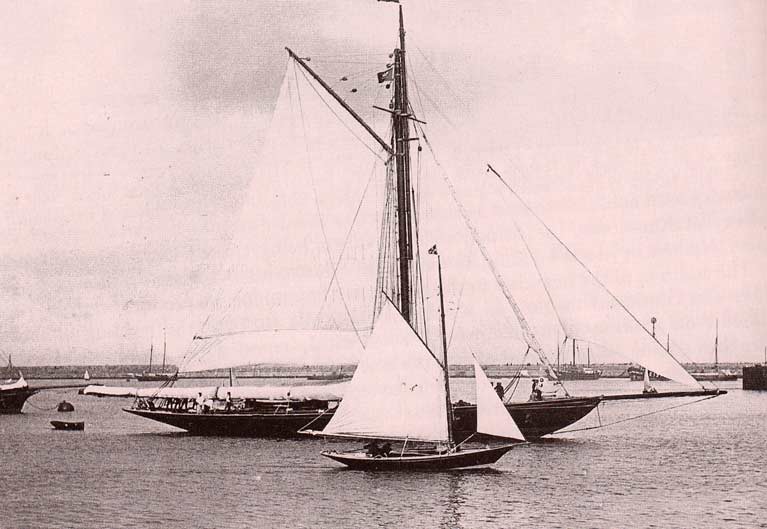 It’s May 1893, and Dublin yachtsmen get a first chance to see the new Britannia as she calls to Kingstown on Dublin Bay under a very shortened passage-making rig, with owner’s representative Willie Jameson on board during the maiden voyage in rugged weather from the builders in the Clyde to the Solent
It’s May 1893, and Dublin yachtsmen get a first chance to see the new Britannia as she calls to Kingstown on Dublin Bay under a very shortened passage-making rig, with owner’s representative Willie Jameson on board during the maiden voyage in rugged weather from the builders in the Clyde to the Solent
This was the Prince of Wales’ own 122ft cutter Britannia, designed by G L Watson and built on the Clyde by D & W Henderson, with top amateur sailing skipper Willie Jameson of Portmarnock in Dublin - a member of the noted Irish whiskey distilling family - acting as owner’s executive agent throughout the design, build and commissioning project, which was arguably the high point of the Golden Age of Scottish yacht building.
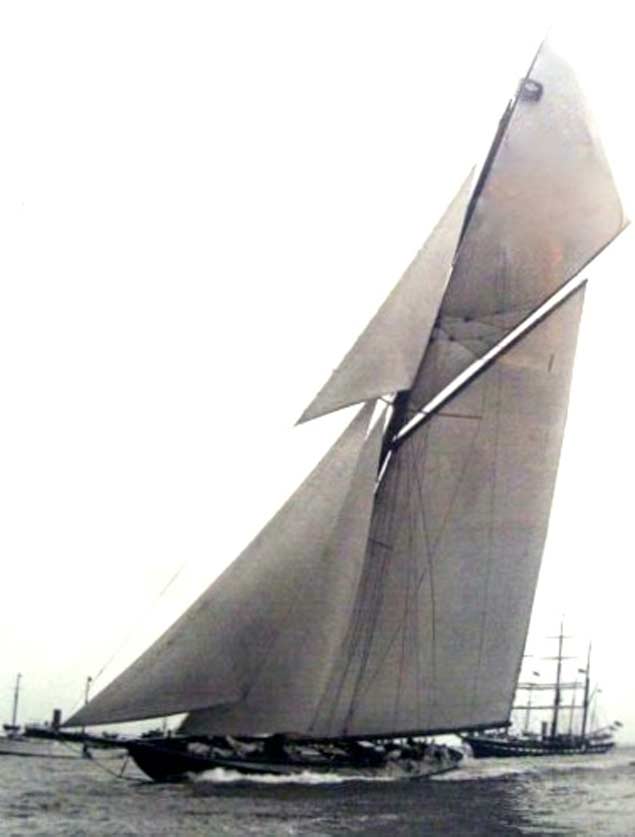 The “Britannia Ideal” as seen under full power while racing during Cowes Week
The “Britannia Ideal” as seen under full power while racing during Cowes Week
Britannia certainly set a high standard for what was thought of in 1893 as “the new look” for yachts, though for some her curved stem was just too much, and they stayed with more traditional clipper bows.
In Ireland from time to time creations of the highest standard appeared from local builders to the plans of international design talent, notable clipper-bowed examples still very healthily in existence being Hal Sisk’s superbly-restored G L Watson-designed 36ft cutter Peggy Bawn, built by Hilditch of Carrickfergus in 1894, and the 43ft Fife cutter Pen Duick, built to a William Fife design in Carrigaloe on Cork Harbour in 1898, and best-known for her long association with Eric Tabarly.
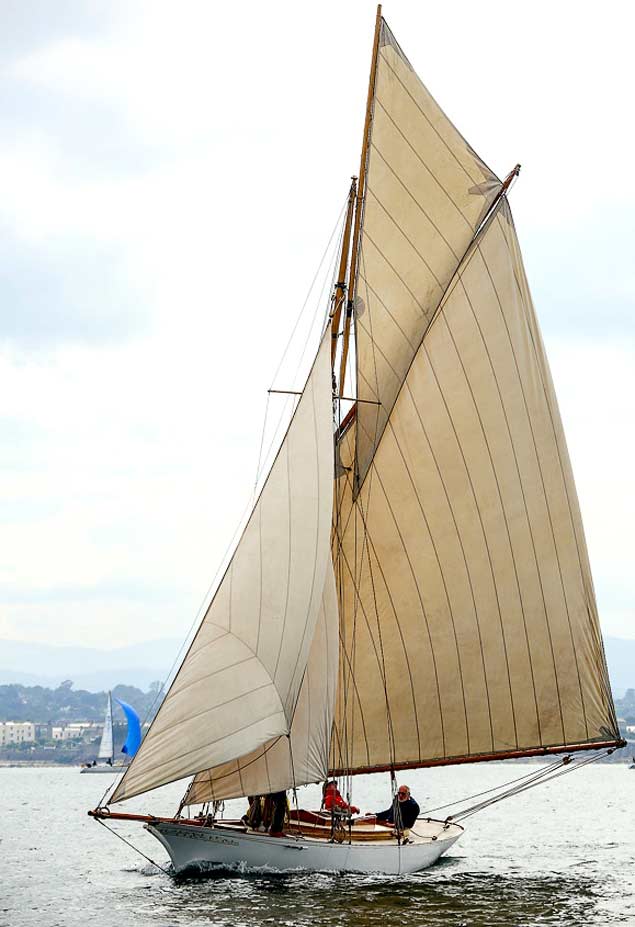 Hal Sisk’s Peggy Bawn - designed G L Watson, built Hilditch of Carrickfergus 1894 - setting a suit of virtually unused cotton sails. They were found among the store of equipment when he bought the classic cutter for a restoration which was completed in 2005. Photo: Afloat.ie/David O’Brien
Hal Sisk’s Peggy Bawn - designed G L Watson, built Hilditch of Carrickfergus 1894 - setting a suit of virtually unused cotton sails. They were found among the store of equipment when he bought the classic cutter for a restoration which was completed in 2005. Photo: Afloat.ie/David O’Brien
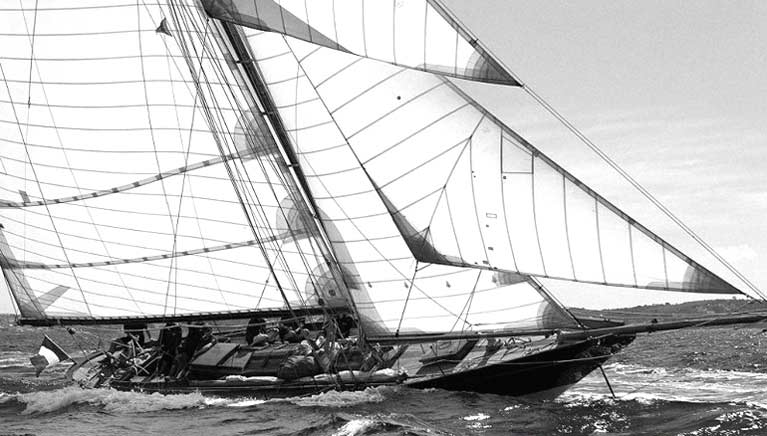 The 43ft Pen Duick of Eric Tabarly fame is a William Fife design built at Carrigaloe on Cork Harbour in 1898
The 43ft Pen Duick of Eric Tabarly fame is a William Fife design built at Carrigaloe on Cork Harbour in 1898
At the same time “spoon-bowed” yachts to Fife’s designs were also appearing, with the Cork Harbour One Designs in 1895, and a series of Belfast Lough One designs from both Fife and Alfred Mylne from 1896 to 1910.
Alfred Mylne became the “go to” designer for good-looking Irish One Designs with the Belfast Lough Stars in 1900 and the Dublin Bay 21s in 1902, then came the 39ft Island Class cruiser-racer yawls in 1910, while in more modern times he was still on the pace with the introduction of Bermudan rig with the 28ft 6ins River Class – now all in Strangford Lough – in 1921, the Dublin Bay 24s in 1938, and the 25ft Glens in 1947.
These were One Design racers, but after World War II in 1945, Crosshaven Boatyard began to function in various forms with fast cruisers and offshore racers, and from it - under Denis Doyle’s stewardship - there emerged some notably handsome craft, particularly the “white Moonduster”, a Robert Clark 47-footer from 1965, the very elegant and successfully functional Gypsy Moth V (also from Robert Clark) for Francis Chichester in 1970, the ruggedly good-looking Sparkman & Stephens 49ft “Blue Moonduster” of 1973, and arguably the star of them all, the handsomely varnished Frers 51 Moonduster of 1981, a yacht with such presence that she seemed to glow.
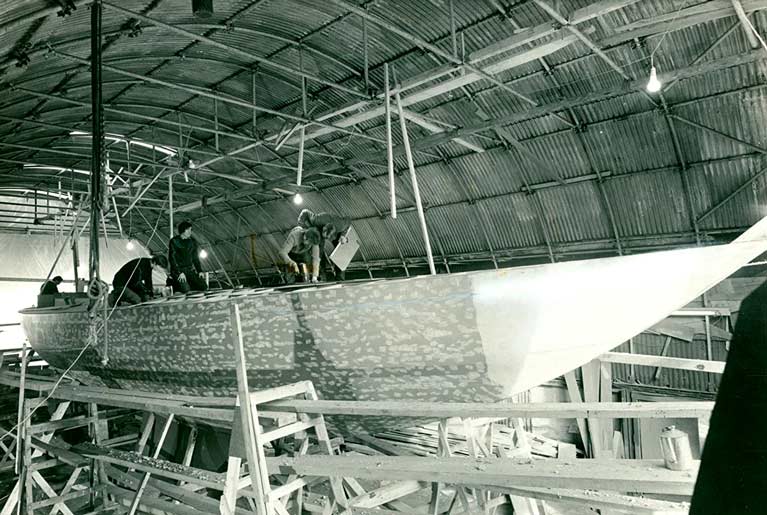 Francis Chichester’s Robert Clark-designed Gypsy Moth V building at Crosshaven Boatyard, January 1970.
Francis Chichester’s Robert Clark-designed Gypsy Moth V building at Crosshaven Boatyard, January 1970.
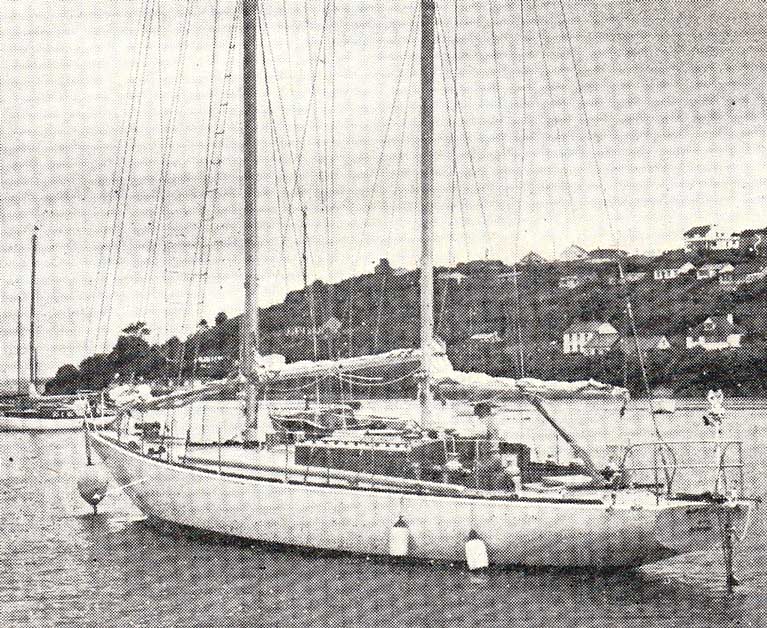 Gypsy Moth V newly-launched at Crosshaven, July 1970. Photo: W M Nixon
Gypsy Moth V newly-launched at Crosshaven, July 1970. Photo: W M Nixon
The fastidious New Zealand-born designer Arthur Robb also had his adherents, with the elegant 37ft yawl Verve (now owned by the Comerford family of Dun Laoghaire) built for Paul Campbell by Jack Tyrrell of Arklow in 1964, while at the same time at Bangor Shipyard in the shores of Ballyholme Bay, the long task of building the 42ft Jaynor was under way for Ivan Selig of Belfast with Admiral's Cup prospects for 1965 in mind.
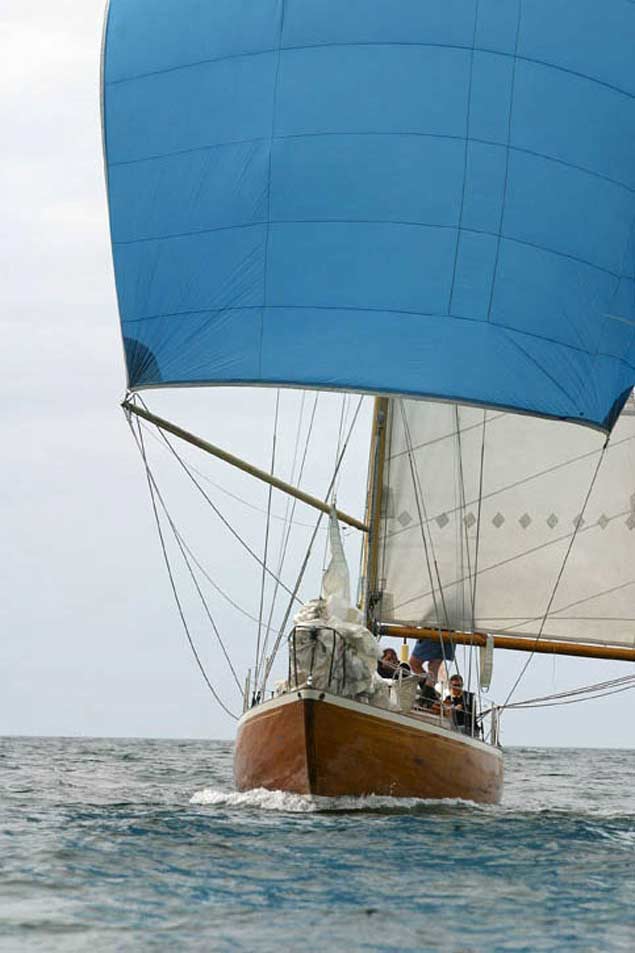 The Arthur Robb-designed Jaynor, built at Bangor Shipyard on Ballyholme Bay in 1967, racing at the Glandore Classics under the ownership of the late Dickie Brown in 2003.
The Arthur Robb-designed Jaynor, built at Bangor Shipyard on Ballyholme Bay in 1967, racing at the Glandore Classics under the ownership of the late Dickie Brown in 2003.
In fact, Jaynor was built with such total attention to detail (the designer provided a total of 64 exquisitely-finished drawings) that she was barely ready for the 1967 Admiral’s Cup, but she is still very much in existence, a credit to the skills of the Bangor shipwrights, and a worthy addition to the list of beautiful world-standard sailing yachts built in Ireland.
Yet in looking for beautiful yachts with Irish links, should we restrict ourselves to sailing boats? In one of those burrowing searches which have played such a useful role in getting us through the Lockdown, we were looking for one particular black and white photo, and instead came across something else altogether.
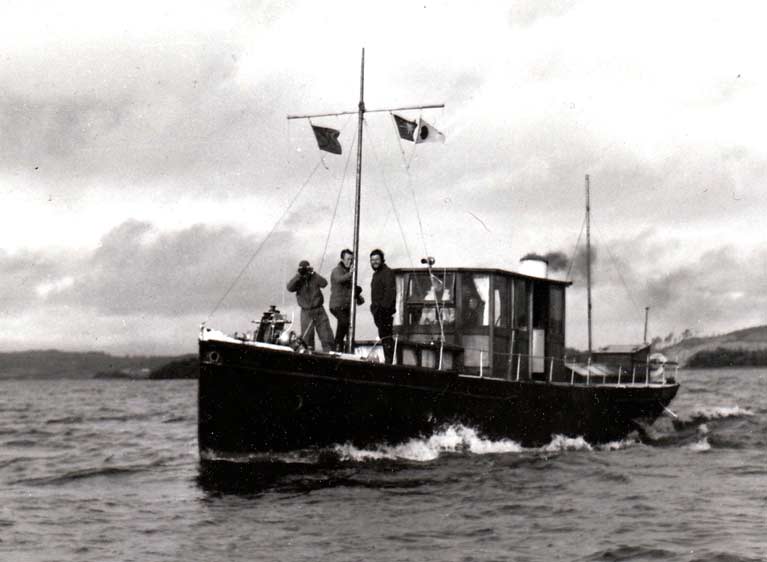 The 58ft Phoenix – built in Waterford of Lowmoor iron in 1872 - in fine “steaming” form on Lough Derg, September 1982. Photo: W M Nixon
The 58ft Phoenix – built in Waterford of Lowmoor iron in 1872 - in fine “steaming” form on Lough Derg, September 1982. Photo: W M Nixon
This image of John and Sandra Lefroy’s Killaloe-based 58ft 6in Phoenix steaming briskly at full chat across Lough Derg just for the hell of in the Autumn of 1982 brings back memories and then some. It was taken after Phoenix provided Committee Boat services at the Helmsman’s Championship at Dromineer in Shannon One Designs, with Dave Cummins of Howth – crewed by Gordon Maguire and Mossy Shanahan - successfully defending the title he’d won in Squibs at Howth in 1981.
“Steaming” isn’t quite the word, as Phoenix is diesel-powered and at season’s end her injectors needed a little attention. But as she happened to have been built way back in 1872, this impression of a steam-ship at speed was just what was needed, and in a flash of brief Autumn sunshine we also got a colour version of this photo which graced the cover of Motorboat & Yachting, where the plume of funnel smoke was just the job to emphasise that Phoenix was already 110 years old, and now she is within two years of her 150th anniversary.
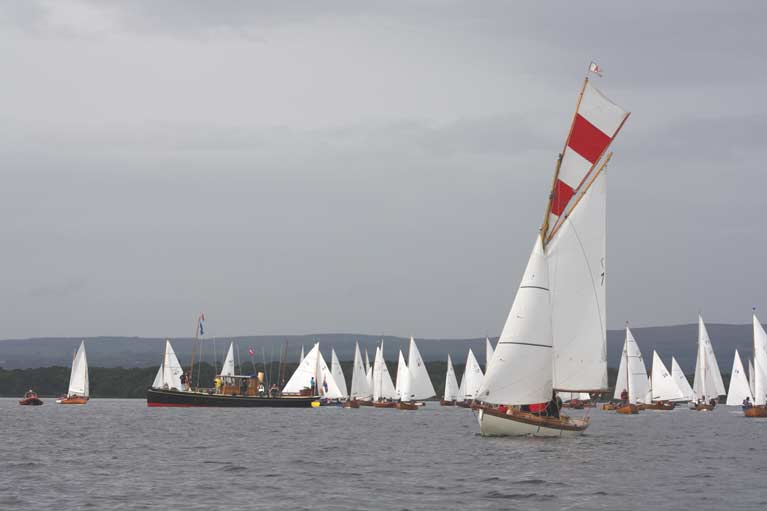 Golden Oldies Triumphant…..The 1872-vintage Phoenix on Committee Boat duty at a Classics Regatta at Dromineer on Lough Derg with the 1898-built Howth 17 Aura in the foreground, and the lake filled with boats of the Water Wag class (1887 & 1900) and the Shannon One Designs (1922). The combined age of the boats in this photo exceeds 2,000 years. Photo: Gerardine Wisdom
Golden Oldies Triumphant…..The 1872-vintage Phoenix on Committee Boat duty at a Classics Regatta at Dromineer on Lough Derg with the 1898-built Howth 17 Aura in the foreground, and the lake filled with boats of the Water Wag class (1887 & 1900) and the Shannon One Designs (1922). The combined age of the boats in this photo exceeds 2,000 years. Photo: Gerardine Wisdom
Although in the brisk breeze there was quite a lively Lough Derg chop running, with her beam of only 10ft, heavy displacement and hollowish waterlines forward, the Phoenix is steady as a rock nd slicing through it with ease, with her bow-wave well aft from the sharp straight stem, for this is one classy yacht. And just seeing her again was a reminder that while G L Watson made his name in superb sailing yachts, the bread-and-butter income from his design practice came from creating large, luxurious and extremely elegant steam yachts for the ludicrously wealthy industrialists and railroad barons to be found on both sides of the Atlantic in the final decades of the 1900s.
In doing this, Watson was emulating the path set by an almost-forgotten Irish yacht designer, St Clare John Byrne (1831-1915), the son of a ship owner from Ireland who had settled in Birkenhead across from Liverpool with his Scottish wife, where the son soon became a rising star in the design offices of the busy shipyards. He proved to have an exceptional talent for creating large (some of them extremely large) steam yachts, but he was also the designer of the steam-and-sail 152ft barquentine Sunbeam of 1874, which the global railway engineer Thomas Brassey cruised round the world with his family.
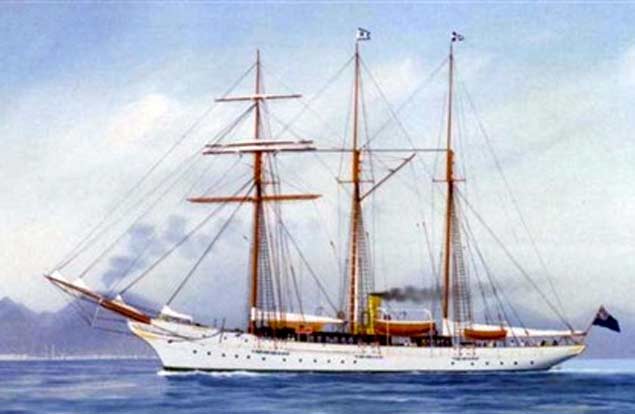 Thomas Brassey’s world-girdling 152ft auxiliary barquentine Sunbeam of 1874 was St Clare Byrne’s most famous design
Thomas Brassey’s world-girdling 152ft auxiliary barquentine Sunbeam of 1874 was St Clare Byrne’s most famous design
Like Watson a decade or so later, Byrne could create steam yachts which combined classic beauty with on-board comfort and sea-going power, works of art which could match any sailing yacht for beauty, and this was something which came very much to mind in delving back into the origins of Phoenix. She was designed and built in the Waterford region, using quarter inch Lowmoor iron, by the Neptune Shipyard to the designs of Andrew Horn, yet according to some records she was built by the Malcolmson Brothers of Portlaw.
“Waterford region” is used advisedly, for we’re into complex territory here. Portlaw is that extraordinary 19th Century “model village” 19 km upstream of Waterford city on the River Suir, built up as a planned industrial unit from 1825 onwards by the Malcolmson family to such a state of prosperity that, by its peak, it was employing 1800 people – with housing provided – at a time when much of rural Ireland was in grinding poverty.
It seemed the Malcolmson brothers could turn their hand to anything, and their development of steamships in tandem with the growth of their conglomerate meant that at one stage, they actually owned more steamships in vessel numbers than any other single company in the world.
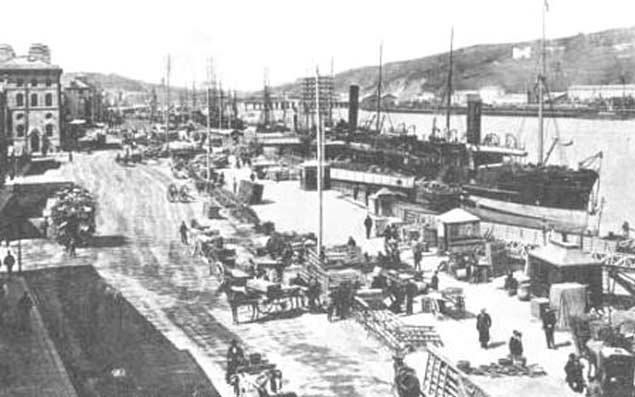 The busy quays in Waterford around 1900. The Malcolmsons had been so successful in pioneering steamship building and development in the middle decades of the 19th Century that at one stage they had the numerically-largest fleet of steam-driven vessels in the world
The busy quays in Waterford around 1900. The Malcolmsons had been so successful in pioneering steamship building and development in the middle decades of the 19th Century that at one stage they had the numerically-largest fleet of steam-driven vessels in the world
But what goes up eventually comes down, and by the 1870s cracks were beginning to appear, so although the Phoenix may have been built in Portlaw, as the industrial edifice created there began to crumble, the ship-building seems to have been hived off to this Neptune Shipbuilding company more directly linked to Waterford city, although the Neptune Ironworks had been associated with Portlaw since 1840.
Whatever the story – and it’s surely worthy of a TV drama series, for there were all sorts of family tensions involved – Andrew Horn, the in-house yacht designer who drew the plans for Phoenix, has emerged in the 1880s as the designer to the Neptune Shipbuilding Company in Waterford, and in 1882 with some input from St Clare Byrne, he designed and oversaw the building in iron of the 77ft steam yacht Maritana, all of 30 tons in deadweight and 56 tons TM, but skinny like a greyhound in the Phoenix style.
Maritana was built for Thomas St Leger Atkins of Waterford, and the photo of her in her first year afloat says everything, elegantly posed as she is at anchor in the river off Reginald’s Tower as a proud statement of Waterford’s achievement. In design terms, Andrew Horn has moved on from Phoenix’s straight stem and has given Maritana a clipper-bowed look which to my mind, when combined with a sheerline of saintly restraint and the neatly-tucked counter stern, makes her the best-looking yacht – sail or power - to have ever come out of Ireland, and the fact that she was both Irish-designed and built is a bonus.
Waterford’s high opinion of her was shared in Cowes, where she was awarded the Concours d’Elegance at the regatta in 1884. But it couldn’t be an Irish story without the inevitable serving of sadness to round it out. Maritana was the last vessel created by the Neptune Shipbuilding Company. It followed the Malcolmson conglomerate into oblivion soon after her completion.
As for what happened subsequently to the exquisite Maritana, according to the ever-helpful USB of all Lloyd’s Registers (assembled from its foundation in 1878 to the final edition in 1980 by the Association of Yachting Historians), after some years in Waterford, she was sold to Milford Haven in Wales, and by the turn of the century she was in Belfast Lough ownership before returning to southwest Wales, but with an owner based in Sunderland. Eventually, she disappears from the records. Some well-resourced research department may wish to follow the trail. But for the rest of us, that captured moment of the most beautiful Irish yacht of all, anchored off Waterford in 1882, is enough to be going on with.
Take a Bow! How Should Yachts Really Begin & End?
The accepted and popular shapes of boats and yachts in different ages changes so much that you’d be forgiven for thinking that their functions also change completely to suit the requirements of each new era. Of course, design development, measurement rule changes, and new ways of construction are major contributing factors in re-configured appearance from one period to the next. But beyond that, there’s the matter of taste and what people have become accustomed to - the Beauty of one age can be the Beast of the next.
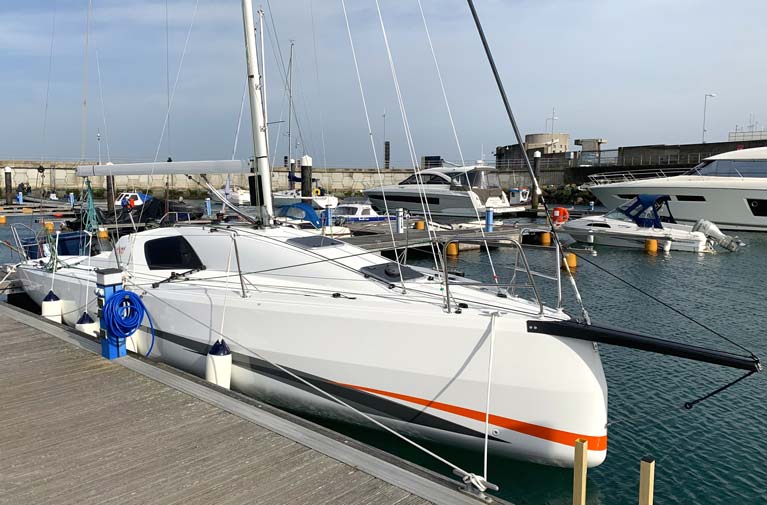 Take a bow today….the new-style stem on the MGM Boats-imported Sun Fast 3300 Cinnamon Girl as seen last month in Dun Laoghaire. Photo: Afloat.ie/David O’Brien
Take a bow today….the new-style stem on the MGM Boats-imported Sun Fast 3300 Cinnamon Girl as seen last month in Dun Laoghaire. Photo: Afloat.ie/David O’Brien
8 Metre Class
Eddie English of Cobh sent us wandering along a picturesque section of memory lane the other day when he came up with a collection of photos by Pascal Roche showing the quartet of International 8 Metres which were very much the style-setters on Cork Harbour in the 1950s and 1960s, and a quickfire exchange of thoughts about them and the people in them was just the job for some diversion from the inevitable contemplation of the ill-effects of The Enemy of the People, aka Covid-19.
For by classic standards, every one of those Cork “straight Eights” was a beauty, dating as they did from the vintage years of the class in the 1930s. We hasten to say they weren’t eight metres long - they were designed to a formula in which, once the maths were completed, the answer was eight metres, and the result was boats of long and stylish overhangs which were in the 47ft to 50ft overall length range.
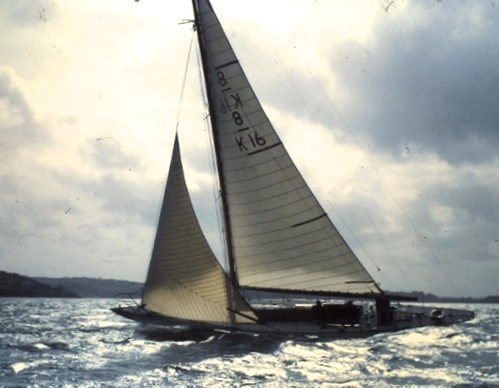 All four Cork Harbour International 8 Metres were built in different countries – this is the longest of them, Perry Goodbody’s 50ft Christina of Cascais, designed by Tore Holm and built in Sweden in 1936. Photo: Pascal Roche
All four Cork Harbour International 8 Metres were built in different countries – this is the longest of them, Perry Goodbody’s 50ft Christina of Cascais, designed by Tore Holm and built in Sweden in 1936. Photo: Pascal Roche
As it happened, the Cork group encompassed both extremes, with Sam Thompson’s Wye being a slip of a thing with minimal headroom, while Tom Crosbie’s If was one of the heftiest International Eights ever built, and even managed standing headroom. Needless to say, Wye was a flyer in lighter winds, but was remarkably wet offshore, as I discovered when delivering her from Cork with new owners to the Clyde at Easter 1968, when the wind remained very determinedly brisk and cold out of the east.
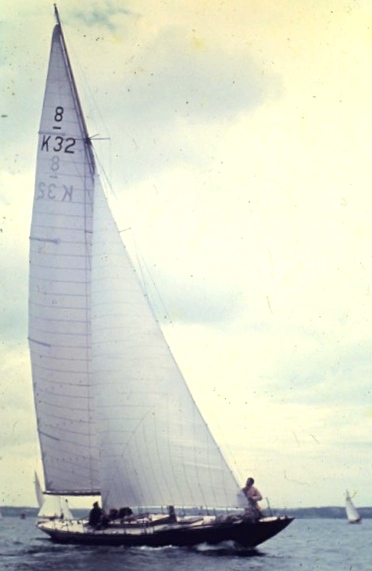 The little one…..Sam Thompson’s Wye was designed by Charles E Nicholson and built by Camper & Nicholson in 1935. Her first owner requested that she be as much as possible like a miniature of Thomas Sopwith’s almost-successful Nicholson-designed America’s Cup Challenger Endeavour of 1934.
The little one…..Sam Thompson’s Wye was designed by Charles E Nicholson and built by Camper & Nicholson in 1935. Her first owner requested that she be as much as possible like a miniature of Thomas Sopwith’s almost-successful Nicholson-designed America’s Cup Challenger Endeavour of 1934.
By contrast, If could give a good account of herself offshore and in a breeze racing out of Crosshaven. She was thus a regular star in the West Cork Regattas when they were still known as the West Cork Regattas and people didn’t feel the need to call them Calves Week. But it was Denis Doyle with Severn II who was the most determined RORC campaigner. This resulted in a memorable (or perhaps better forgotten) experience in the RORC’s Beaumaris to Cork Race, which started in the Menai Straits in North Wales.
As the Coningbeg Lightvessel off the Saltee Islands was a mark of the course, there was a tradition on Irish cruising and offshore racing boats of carrying up-to-date newspapers which could then be chucked aboard the manned lightship as they went past. With Severn II in the lead, her distinguished visiting helmsman (who had better remain anonymous) was so determined to complete this manoeuvre in close style that he failed completely to notice that the lightship’s boom, to which service boats would be secured, was slightly extended. The result that while Severn did indeed sweep beautifully alongside and neatly deposit the newspapers, there was a crash from aloft, and there was her mast – gone.
The great Denis, who’d been off watch, took it all in his usual phlegmatic style, and they cleared the wreckage away and set off under the little auxiliary engine for the slow haul to the nearest port at Dunmore East, for in those days Kilmore Quay was a very primitive place with no berthing of any kind for yachts. Denis then retired below again to resume his sleep, but was awakened some time later by suspicious-sounding noise and kerfuffle in the cockpit.
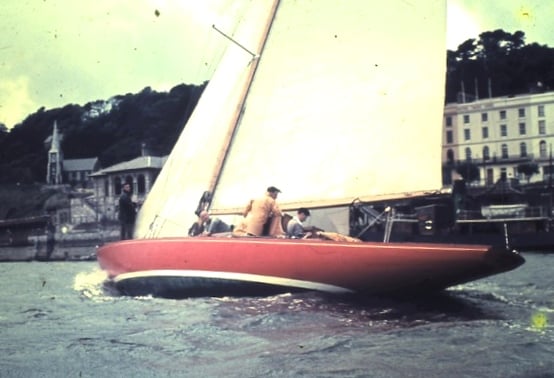 Denis Doyle’s Severn II off the original Royal Cork YC clubhouse at Cobh. Designed by Alfred Mylne and built in Scotland in 1934, Severn II was the second international metre-style boat Denis Doyle raced offshore, as he started his RORC career with the Thirty Square Metre Vanja IV. Photo: Pascal Roche
Denis Doyle’s Severn II off the original Royal Cork YC clubhouse at Cobh. Designed by Alfred Mylne and built in Scotland in 1934, Severn II was the second international metre-style boat Denis Doyle raced offshore, as he started his RORC career with the Thirty Square Metre Vanja IV. Photo: Pascal Roche
He erupted on deck (in his pyjamas, mark you) to find that the mast-breaking helmsman had observed that a ship was about to pass nearby, and as they’d no means of signalling, he was trying to set off a flare in order to get a tow, as he was convinced the little engine would never get them to port.
That did it for Denis. “My God,” says he, “You break my mast. And now you’re trying to set my boat on fire. We’ll get to Dunmore East or somewhere else under our own power. And that’s the end of it”.
With boats so beautiful in the classic style, while the 8 Metre class have long gone from Crosshaven, they’ve been revived in restored or even new-build form all over the world. But as they’re specialist craft totally at variance with the modern boats of extremely short ends and straight or even reverse stems, the contemporary world of the long and elegant International 8 Metre Class is a very private place in which the strongest fragrance is the reassuring aroma of wealth.
As for the design preferences which set the shape of the Cork-based 8 Metres, it is also seen in another 1930s creation, the Dublin Bay 24s, which lasted more than fifty years and have since seen restorations at various stages, the most complete being Periwinkle based in Dun Laoghaire.
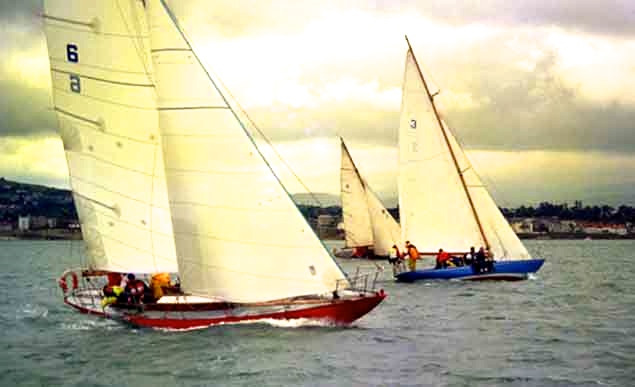 Classic good looks. Dublin Bay 24s racing in their Golden Jubilee regatta in 1997. Photo: W M Nixon
Classic good looks. Dublin Bay 24s racing in their Golden Jubilee regatta in 1997. Photo: W M Nixon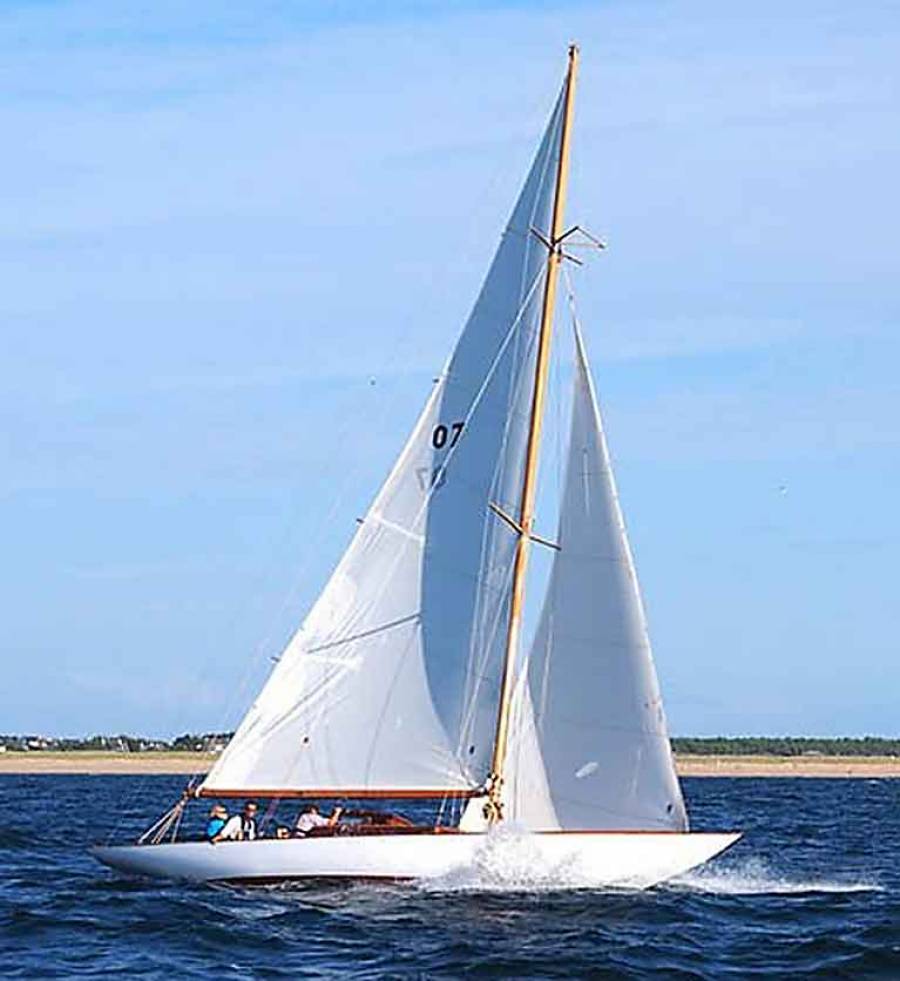 The restored Dublin Bay 24 Periwinkle. In addition to providing more than fifty years of great racing in Dublin Bay, the boats were cruised extensively, and in 1963 one of them won the RORC Irish Sea Race
The restored Dublin Bay 24 Periwinkle. In addition to providing more than fifty years of great racing in Dublin Bay, the boats were cruised extensively, and in 1963 one of them won the RORC Irish Sea Race
Meanwhile, in mainstream sailing, we’ve now entered an era in which even Superyachts seem determined to mimic the trend in the most advanced offshore racers in having vertical or even reverse stems. You can understand the dictates of fashion (however odd) pushing their way through even into superyacht design, so all power to Ron Holland, who has tried to design his superyachts so that they look elegant in the classic style, with matching overhangs fore and aft.
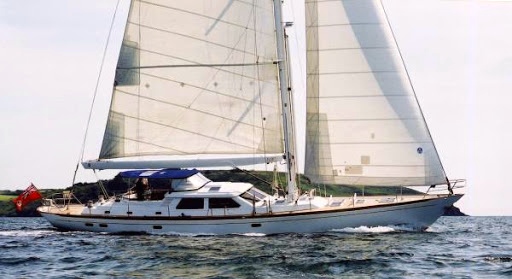 Ron Holland’s personal dreamship, the 73ft Golden Opus, shows his preference for classical elegance
Ron Holland’s personal dreamship, the 73ft Golden Opus, shows his preference for classical elegance
This is something of which seasoned professional crews heartily approve, for as one of them said with some vehemence: “If you’re trying to get some work done right on the stemhead in a rough seaway in a superyacht with a vertical stem, you’ll find you’re being power-hosed all the time, and can regularly expect to be washed like a rag doll – sometimes with painful consequences - back along the deck. But when you’re right forward in one of Ron’s boats, the seas are sweeping across the deck safely astern of you, and all’s well with the world”.
Superyacht Sea Eagle II
Despite that, there are already superyachts sailing with reverse stems, which may ultimately mean that they’ll have to devise ways of doing any necessary work at the stemhead from a special compartment inside the hull. But that is not a problem most of us will ever have to deal with, although it will be a thought for an Irish professional sailor who is on the commissioning crew of the latest mega-blast on the Superyacht scene, the 81 metre aluminium-hulled Dykstra-designed Sea Eagle II (that’s 266ft in old money) which emerged with inches to spare from the enormous Royal Huisman construction sheds in The Netherlands on January 8th, the largest yacht ever built by the company.
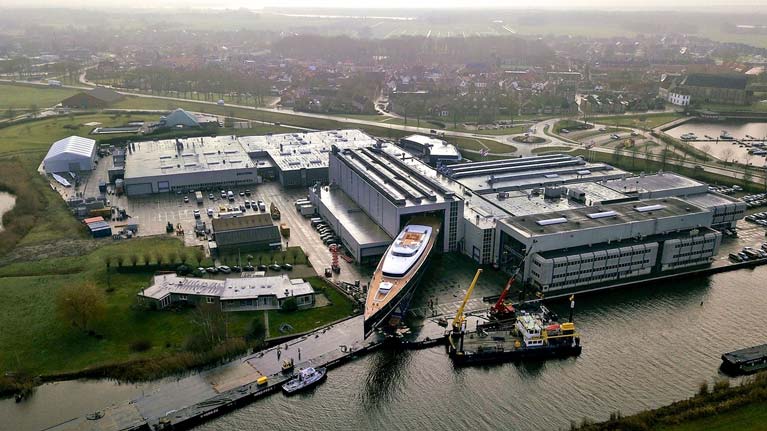 The big one. The new 81m Sea Eagle II emerges with inches to spare from the Royal Huisman sheds in The Netherlands with inches to spare on January 8th. At 266ft and built in aluminium, she is the largest vessel ever completed by the firm.
The big one. The new 81m Sea Eagle II emerges with inches to spare from the Royal Huisman sheds in The Netherlands with inches to spare on January 8th. At 266ft and built in aluminium, she is the largest vessel ever completed by the firm.
Owing to the pandemic lockdown, work is currently on hold in the completion process. But with a vessel this size (properly speaking, she’s a ship) they’ve a shore-based caretaker crew of six including our Irish sailor, of whom four are always on board while the others are in dedicated accommodation ashore. There, all enjoy the services of the crew chef, so the biggest problem may well be keeping the personal weight down.
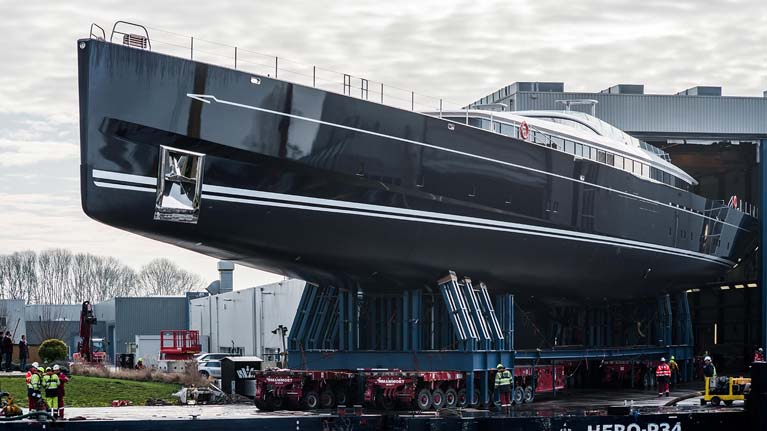 More of a ship than a yacht, Sea Eagle II is privately owned but may be available for charter.
More of a ship than a yacht, Sea Eagle II is privately owned but may be available for charter. Although she has substantial twin engines, Sea Eagle II is designed as a serious sailing proposition
Although she has substantial twin engines, Sea Eagle II is designed as a serious sailing proposition
Keeping weight down in the ends of his yacht has always been one of the priorities of Gerry Dykstra, who founded the design company in 1969. Thus although his own much-voyaged 53ft Bestevaer 2 is completely straight-stemmed with a short stern to match, within the accommodation there is virtually nothing in the forward and aft sections.
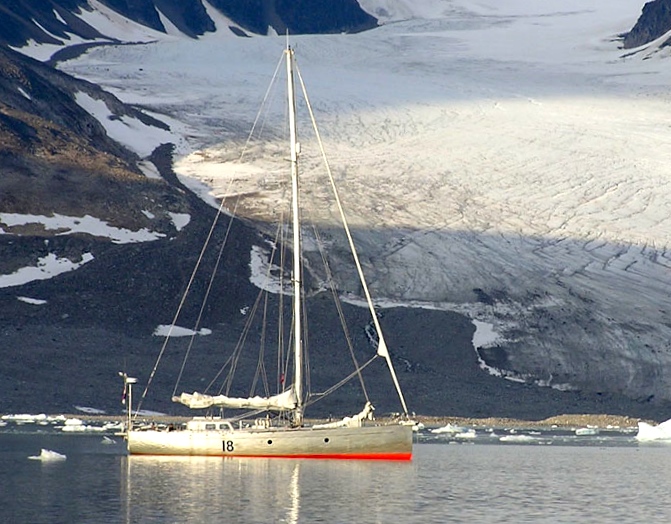 Gerry Dykstra’s 53ft Bestevaer 2 in Svalbard. All accommodation and weight is concentrated as much as possible towards the centre of the boat
Gerry Dykstra’s 53ft Bestevaer 2 in Svalbard. All accommodation and weight is concentrated as much as possible towards the centre of the boat
 Innovative designer Gerry Dykstra – his personal heroes are G L Watson and Nat Herreshoff
Innovative designer Gerry Dykstra – his personal heroes are G L Watson and Nat Herreshoff
Intriguingly, however, Dykstra says that his own yacht design heroes are Scotland’s G L Watson and America’s Nathanael Greene Herreshoff, who were in the vanguard in the introduction of bows with long overhangs in the 1890s. But in order to grasp that and how it came about, maybe we should take a quick canter through stem development in the 1800s.
Fishing boats always tended to have short overhangs forward, for several reasons, not least of them being the fact that their crowded harbours meant that with bowsprits raised, they could pack more boats in. Many yachtsmen felt that the straight stem type was also best for their needs, but the great sail trading ships and naval vessels gradually developed bowsprits which set so many multiple headsails that they became spars within their own right, and were best supported by the development of the clipper bow. It looked just right as it combined elegance with functionality, and by the time the schooner America arrived across the Atlantic in 1851, clipper bows seemed as popular as straighter stems.
This became even more the case in the 1860s, the great era of the racing schooners, which is when Ireland comes in on the story in a significant way, as the most successful schooner was linen magnate John Mulholland of Belfast’s “wonderful Egeria” of 1865, winner of many trophies during a long career.
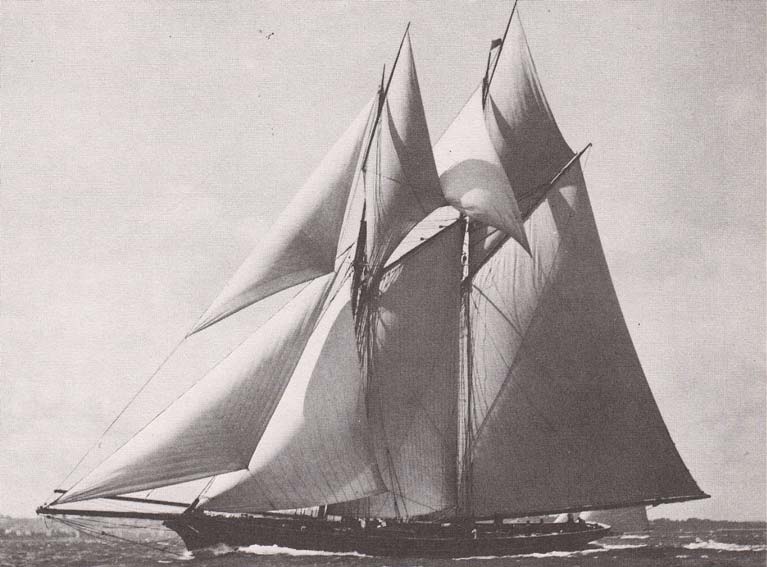 The triumph of the clipper bow – John Mulholland’s schooner Egeria was the top performer in the 1860s and ’70s.
The triumph of the clipper bow – John Mulholland’s schooner Egeria was the top performer in the 1860s and ’70s.
Yet in time, design developments and new rating rules saw a revival of cutters, and straight-stemmed ones at that, and this time the Irish input was by whiskey king John Jameson of Dublin, whose Irex of 1884 (designed by Alexander Richardson of Liverpool) was in the trophy lists for the rest of the 1880s.
Everyone thinks that it was uber-grocer Thomas Lipton of Monaghan and Glasgow who first demonstrated the commercial benefits of high profile yachting campaigns with his publicity-laden America’s Cup challenges. But it was the notoriously shy John Jameson who was ahead of the curve in this area, for every time Irex won a trophy, as she did the classic regatta circuit right through the season at many venues, the name John Jameson would appear in the sports pages, and up and up went the sales of his Irish whiskey.
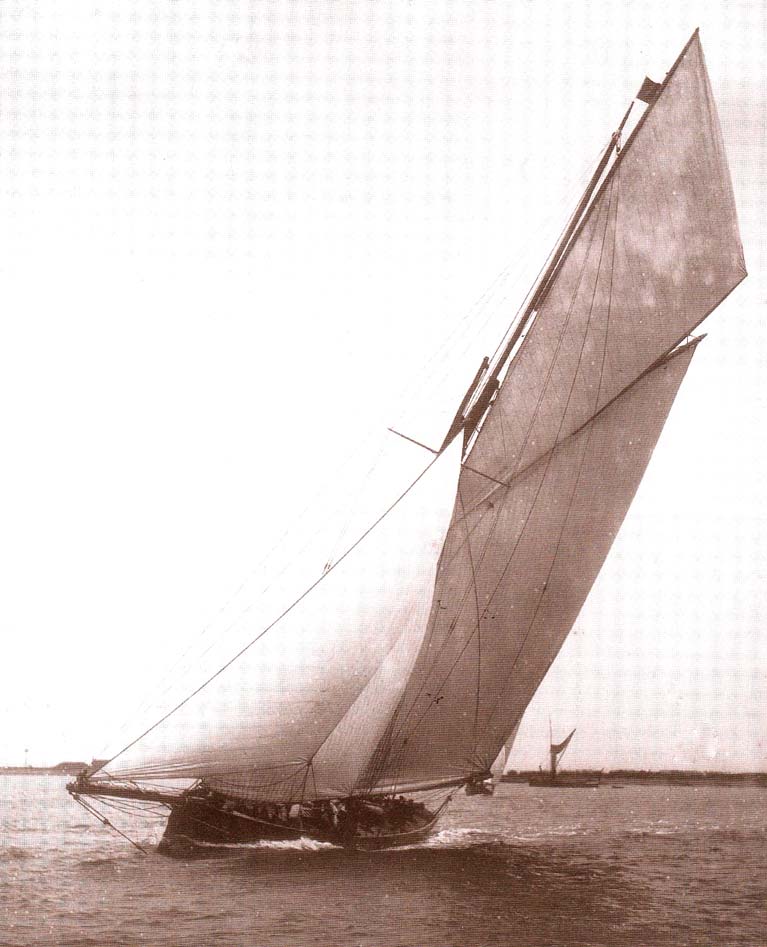 Back to the straight stem – John Jameson’s Irex was the most successful cutter racing in the 1880s
Back to the straight stem – John Jameson’s Irex was the most successful cutter racing in the 1880s
But while John Jameson was shy, his brother Willie was an exuberant extrovert who was recognized as one of the best amateur sailors of his generation, and through his association with the success of Irex he became part of the Prince of Wales’s sailing set. So much so, in fact, that when the Prince ordered the construction of the new royal racing yacht Britannia in the late Autumn of 1892 to designs to G L Watson, it was Willie Jameson who was appointed Owner’s Representative for the project.
But there was even more of an Irish element to it than that, as Britannia was generously commissioned in order to provide a training partner for Valkyrie II, the Watson-designed America’s Cup challenger ordered a few weeks earlier from Watson by Lord Dunraven of Adare, Co Limerick.
All of that’s as may be, but in terms of our story about the development of bow shapes, the fact is that both Valkyrie II and Britannia had the new-look long overhang bows, and though in time Britannia came to be thought of as the perfect ideal of what a classically good-looking yacht should look like, when she and her near sister Valkyrie II appeared in the Spring of 1893, they were many who didn’t like the looks of the stems at all, and described them somewhat disparagingly as “spoon bows”.
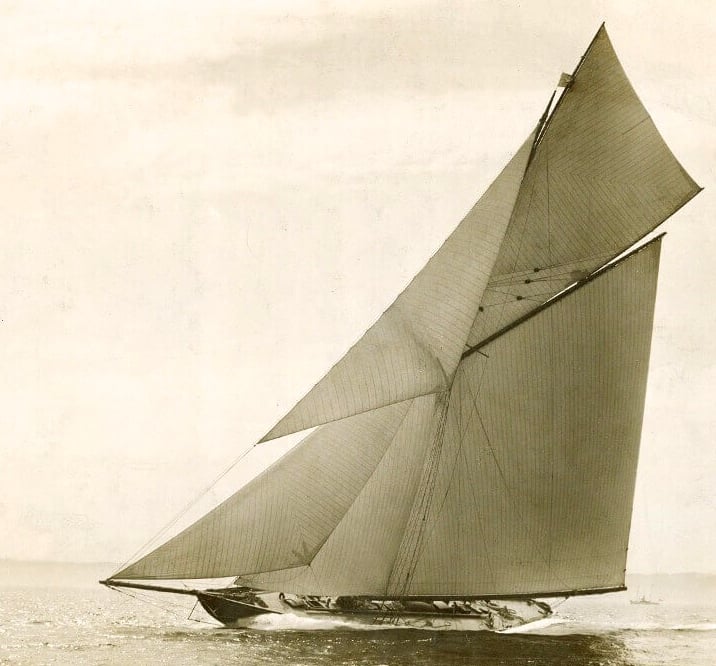 The new G L Watson-designed Britannia developing power and speed in 1893, when her innovative stem was disparaged as “a spoon bow”. For her first four very successful seasons, the Royal Sailing Master was Willie Jameson of Portmarnock, and in time her hull shape became accepted as classically elegant.
The new G L Watson-designed Britannia developing power and speed in 1893, when her innovative stem was disparaged as “a spoon bow”. For her first four very successful seasons, the Royal Sailing Master was Willie Jameson of Portmarnock, and in time her hull shape became accepted as classically elegant.
Yet today Gerry Dykstra of the vertical stems is enthusiastic in his admiration of the work of G L Watson (who of course introduced many other performance-enhancing design concepts) and he’s equally admiring of Nat Herreshoff, whose successful America’s Cup defenders if anything went even further in extending the bow overhang.
The idea underlying it all was that when the yacht was sailing, the long overhangs effectively lengthened the working waterline length thereby increasing the boat’s speed potential, and in practice, this was so evidently true that within three decades the RORC Rule for providing a handicap rating for the newly-developing sport of offshore racing was punitive in its treatment of long overhangs.
Myth of Malham
So much so, in fact, that some very odd boats soon began to appear, with their ultimate expression coming in 1947 with John Illingworth’s 40ft Myth of Malham, which won everything on this side of the Atlantic, but didn’t do so well in America, where they reckoned that they should have rating rules which encouraged the success of yachts that reflected the priorities of classic nautical design beauty.
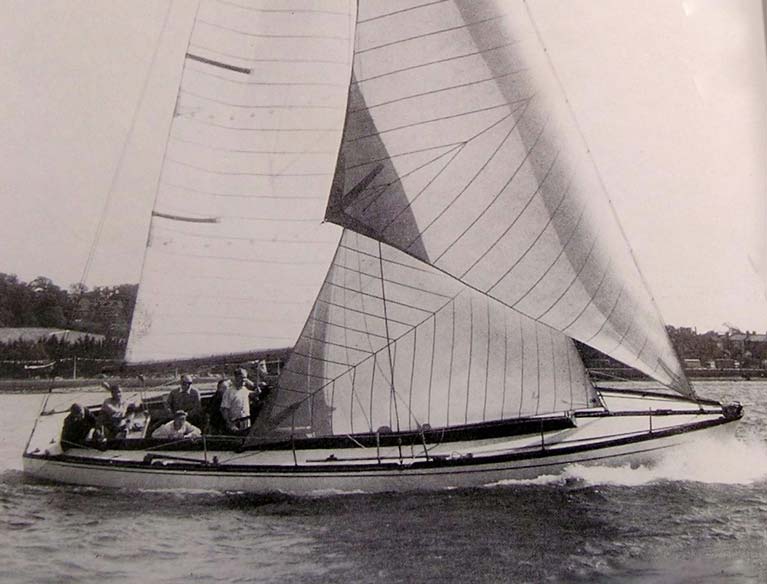 John Illingworth’s Myth of Malham, built in 1947 to designs by Laurent Giles with very considerable input by the owner. As the RORC rating rule penalized long and elegant overhangs, Myth was built (by Hugh McLean in Scotland) just about as short-ended as possible.
John Illingworth’s Myth of Malham, built in 1947 to designs by Laurent Giles with very considerable input by the owner. As the RORC rating rule penalized long and elegant overhangs, Myth was built (by Hugh McLean in Scotland) just about as short-ended as possible.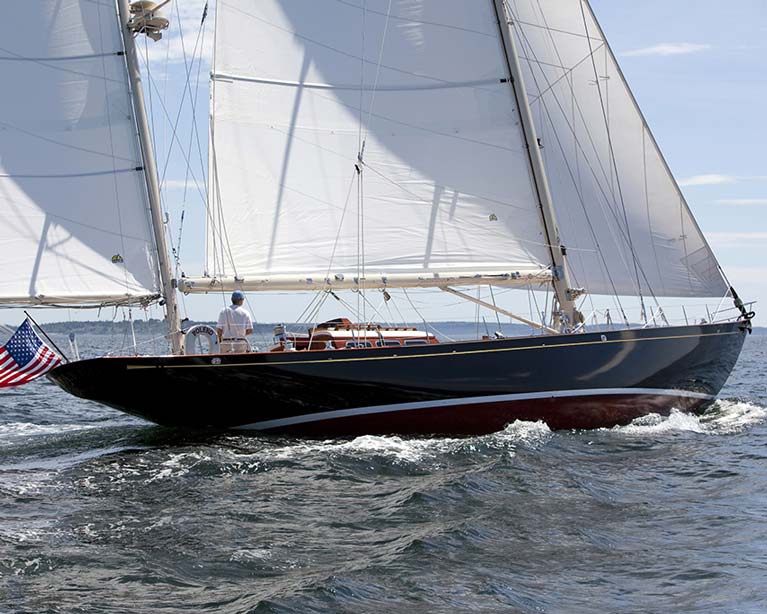 The successful Sparkman & Stephens-designed 73ft Bolero of 1949 vintage. The American offshore rule made no secret of the fact that they wanted to encourage good-looking boats of classic elegance
The successful Sparkman & Stephens-designed 73ft Bolero of 1949 vintage. The American offshore rule made no secret of the fact that they wanted to encourage good-looking boats of classic elegance
Such yachts still appear, but they’re always designated as “Spirit of the Classics”, for in yacht design generally, things are moving so fast that straight stem on a new-build has long ceased to be a matter of comment, and the aspiration now is to create a bow shape which can somehow furrow the briny deep without leaving any foaming furrow marks at all. Strange times indeed. Stay safe.
What Exactly is a Classic Boat?
There are many definitions and a lot of disagreement about that. There is no disagreement, though, about how they look on the water amongst the boating fraternity.
As put to me by that great authority on historic boats, Hal Sisk of the famous Cork building family: “They are drop-down gorgeous.”
Classic boats are often believed to be only of wooden construction, but that definition has changed over recent years as the GRP – glass fibre – designs have aged and become regarded as ‘vintage’ and allowed take part in classic regattas.
Dealing purely with sail, as we do in this column, classic boats in historical terms come for the most famous of the all Ships, to the most mundane of designs and down to the humblest of the first plywood cruisers that enabled many people to get into the sport of sailing in the Sixties.
Amongst the classic boats of sailing are Bristol Channel Pilot Cutters, the earliest Vertues; Maurice Griffith’s first designs, Bermudan-rigged, like the classic Camper & Nicholson craft, Falmouth Oyster Dredgers, West Country Smacks, the sailing workboats of Europe, the double-enders based on the Colin Archer designs, Drascombe Luggers.
There are racing craft from J-class to Flying Fifteens and all the diverse classes of one-design keelboats, racing dinghies from the designs of Uffa Fox to the ubiquitous Mirror and so on. The range is massive, all of which come to mind this week with the announcement that entry has opened for the biennial Glandore Class Boat Regatta in July.
It is being scheduled this year so that classic boats can sail in the beautiful West Cork Harbour as well as participating in the gathering of these boats planned for the 300th anniversary of the Royal Cork Yacht Club in Crosshaven. The organisers say their planning will allow for visiting classic yachts to go onto the Cowes Classic Regatta in the UK.
So there should be a lot of ‘Classics’ in Cork waters this Summer.
July 18 to 25 is the week set for the JPF 2020 Glandore Regatta, “open to all classic sailing boats,” says Glandore Harbour Yacht Club, organisers of the event.
The Regatta will be sailed in the waters of Glandore Harbour and Glandore Bay, between Galley Head and Toe Head. There will be a Parade of Sail at 3 p.m. on Sunday, July 19, around marks laid in the harbour. Classic boat owners who don’t want to participate in the racing can enter for the parade only. The detailed Notice of Race and the costs of entry have been published on the Glandore Club’s website with a discount of 20 per cent on the fee until the end of April.
Classic dinghies have been invited to participate, as well as one-design yachts and the widest of the classic fraternity.
The club tells me that, even before the formal announcement of the opening of the entry list this week, applications were being made for participation.
GHYC was founded in 1985 and has developed steadily. Prior to the Club being set up there are historical references to sailing events in the harbour in the 1830’s when a Glandore Regatta was held. The first Classic Boats Regatta was run in 1992. I have taken part in it a number of times, sailing the late Guy Perrem’s beautiful Mab from Monkstown Bay Sailing Club with a club crew, to compete - and win prizes several times! It was always a good event in which to participate.
Glandore Harbour YC membership’s own cruisers, Dragons, Squibs and dinghies. Its clubhouse was opened in 2013. “Thanks to the continued fund-raising efforts of our committee and members we were able to purchase the adjoining yard in 2015. With a lot of work, it was cleared out, concreted over and a workshop/store constructed in 2016. The addition of a roof created an all-weather space, the new Pavilion, in 2018,” the club says.
The legendary Don Street is one of the club’s members. There are club racing fixtures from May to September. The highlights of these are the At Home Regatta on the June Bank Holiday Weekend, Glandore Regatta in mid-August, and a Dragon Championship every few years. The club runs an extensive training programme which includes the national sailing organisation’s training courses. A sailing programme for local schools is also run each summer.
Eamon Timoney is Commodore. Sally Fegan-Wyles is Regatta Director.; Hal Andrews, the Sailing Secretary. John Williams will lead the Race Committee and Bill Sandberg is the Principal Race Officer.
Listen to the podcast below:
There is enormous interest in the revival of the International 12 Foot Dinghy Class both in Ireland and abroad, in advance of the 250th centenary regatta at Athlone Yacht Club/ Lough Ree Yacht Club at the end of May 2020.
In Cork Harbour, John Murphy and Tom Kirby are renovating Caubeen which was once owned by Captain Jimmy Payne of Royal Munster Yacht Club. It was Caubeen which won the Dinghy World Championships for Ireland in 1924 against Mr Watney of England, Mr Bokre of The Netherlands, and Mr Van Haltern of Belgium. After the programme of races was complete, Bokre and Payne were still on equal points. In the sail-off, Payne and Caubeen won by 29 seconds. Caubeen was probably built in 1923 by James Pluck of Cobh, as one of fifteen dinghies built for £47 2s. 6d. each. In addition to the renovation, a new sail has been ordered for Caubeen from Germany, which should ensure that she is able to compete with the best. Also in Cork, we understand that a Co. Cork boatbuilder has received an order to build a new 12-foot dinghy from scratch in time for the event.
"a Co. Cork boatbuilder has received an order to build a new 12-foot dinghy from scratch in time for the event"
In Dublin, plans are well progressed for the relaunch of Elf which was built in 1931 for a Howth Sailing Club owner and spent much of her racing life in Dublin Bay
In Tralee, 1944 built Sgadan, has been stripped down to her bare timbers and will be varnished ready to defend the Irish Championship which she won in 2018. She also won most of the championships between 1960 and 1970 in the hands of Keith Collie. The Dun Laoghaire and Sutton based boats, Pixie, Albany, Calypso and Dorado which competed in the 2019 Championship are all planning to compete in Lough Ree.
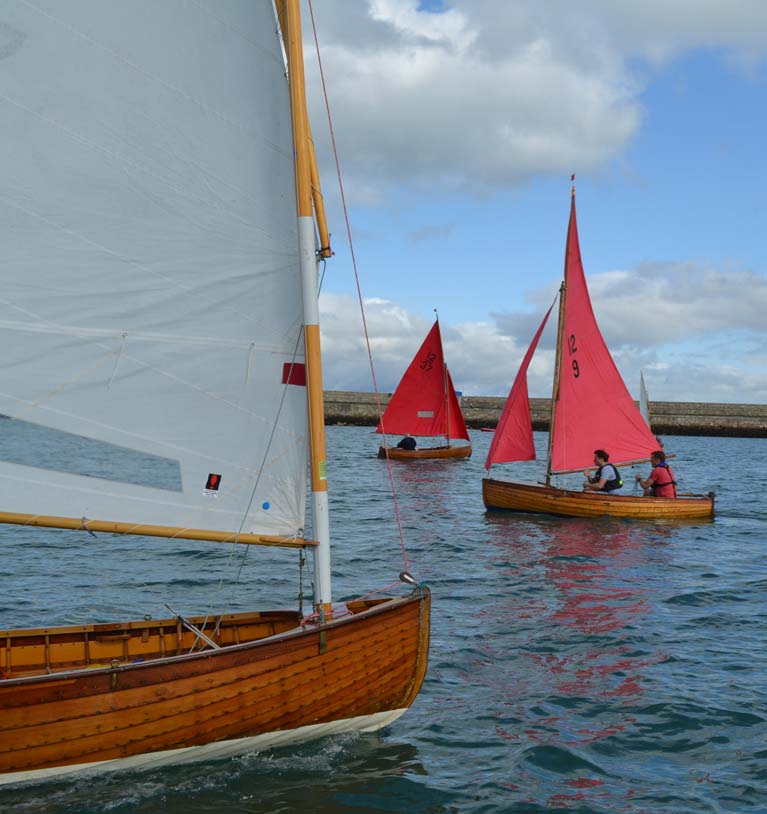 At the regatta there Dublin Bay 12 foot dinghy with mainsail and jib and the International rig with a single sail will race against each other.
At the regatta there Dublin Bay 12 foot dinghy with mainsail and jib and the International rig with a single sail will race against each other.
In Germany, Reinhard Schroeder has encouraged up to four boats to take the long journey including two ferries and to compete at Athlone. This is the first time ever that German 12 Foot Dinghies have come to Ireland to compete against Irish boats in a major regatta.
Also in Uganda, Bert Hemminga is preparing a 12-foot dinghy, probably No 112 Anneke from 1924 in which he won the Bosham(UK) Classic Boat Regatta in 2019. She will be ready for the Athlone Clinkerfest.
In the Netherlands, there are up to 8 boats including Pieter Bleeker of V.W.D.T.P. being prepared for their very first 250th centenary regatta.
Wisely the Canadian, Nicolette Aronldus of Soilspring Sailing Club, already has her 1944 built dinghy Albatros in Europe and is getting ready for racing.
Another visitor from abroad has already been delivered to Ireland, she is the beautiful Scythian from Australia.
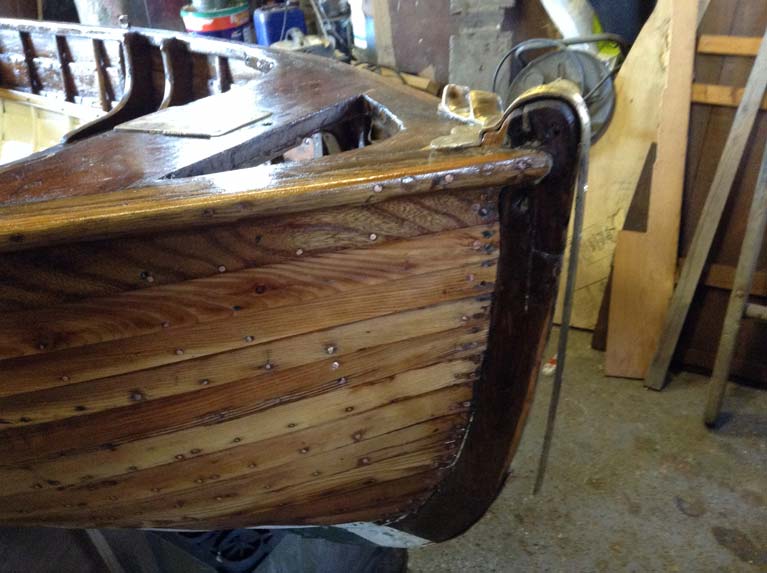 The bow section of the 1924-built Caubeen showing original brass fittings
The bow section of the 1924-built Caubeen showing original brass fittings
Despite Brexit, all the known English boats currently in commission including Doug Branson from Bosham Sailing Club, Colin Blewett from Poole Yacht Club, Margaret Delany and Gerry Murray will be travelling to Athlone to compete.
At the regatta there Dublin Bay 12 foot dinghy with mainsail and jib and the International rig with a single sail will race against each other. Lough Ree Yacht Club Clinkerfest promises to be a great party!
Restoring the 1910 Cutter 'Tally Ho' for Another Fastnet Race
The ongoing restoration of the historic cutter Tally Ho by the intrepid Leo Goolden in Washington State, USA is a sight to behold on youtube writes Pete Hogan.
To those who have not chanced upon his wonderful series of videos (scroll down for one), now numbering over 50 episodes, I highly recommend them as suitable for viewing these long winter nights.
Leo Sampson Goolden is a Boatbuilder, Sailor and Writer from Bristol. He restored a 1947 Folkboat and sailed it, without lifelines, engine, or GPS, across the Atlantic in 2014. From there, as many boat bums do, he got a job on big classic sailing boats which paid well and showed him a different side of the yachting world.
 Leo (above) and below on the folkboat
Leo (above) and below on the folkboat

Then in what must have been a eureka moment, Leo bought, from The Albert Strange Association, the 48-foot gaff cutter Tally Ho (for £1 as she was in need of complete restoration and also had to be moved). Tally Ho, dating from 1910, designed by Albert Strange, won the 1927 Fastnet race, one of only two yachts from the fifteen starters to complete the race. She ended up in the Pacific as a workboat and was pretty well derelict.
The project is not unlike the recent restoration of the Ilen here in Ireland, and the vessels are of similar size. But Leo is doing it all on his own, depending on volunteer help and public donations of money and equipment. Central to this business plan is the making of videos to publicize the project. He’s a young guy, (my guess is about 30), and everything is happening in front of the cameras. He is visibly maturing and gaining in confidence over the plus 25 hours of footage which is now on view. It was heart-breaking to see him admit in one episode that he had cut the top off one of his fingers. His ardent fans are eager to see what happens to the girl who appears every now and then. Watching over all is a cute parrot.
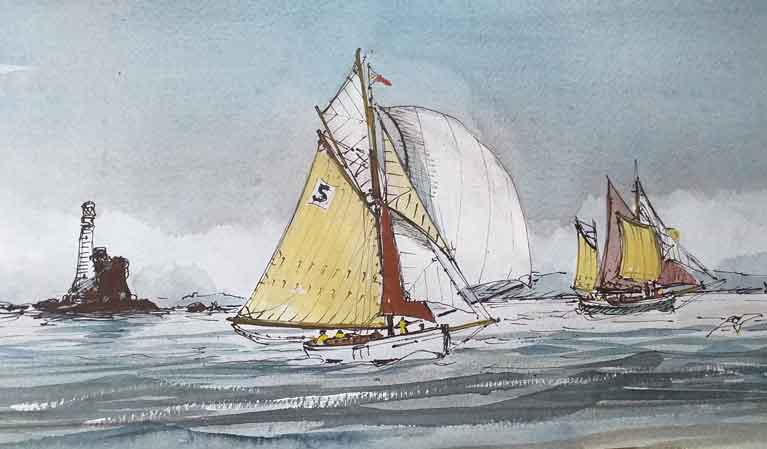 A watercolour of Tally Ho at the Fastnet Rock by article author Pete Hogan
A watercolour of Tally Ho at the Fastnet Rock by article author Pete Hogan
There are many, indeed countless, restoration, adventure, misfortune, quirky, yachting videos online but I can confidently say that Leo’s series, for interest, humour, technical detail, longevity, and courage, beats them all. It’s hard to say, but about two years in, the project is about halfway to completion and the aim is to sail Tally Ho in a Fastnet Race again.
To follow Leo and the restoration of Tally Ho click here
The Eternal Imp is More Than Just a Special Boat
There’s boats. There’s great boats. And then there’s Imp. Our story at the weekend about how George Radley of Great Island and Cobh in Cork Harbour was bringing home his fabulous 1976 Ron Holland-designed 40-footer has drawn a global response and a cascade of special memories (including these photos by Ray Hoare) from a very eclectic collection of people whose lives have been touched at some time by a this boat which – 43 years ago - so perfectly captured the zeitgeist, and in so doing introduced a new type of boat not just to Ron Holland’s already very considerable body of work, but to everyone’s thinking
Imp is now safely back in the Radley boatyard at Rossleague on the north shore of Great Island a little piece of island coastline with highly individualistic innovators. Frank Hederman of the renowned Belvelly Smokehouse is along to the westward, while secluded down the way to the east is Frank Kowalski of Safehaven Marine, creator of some of the most fantastic fast powerboats ever seen in Ireland.
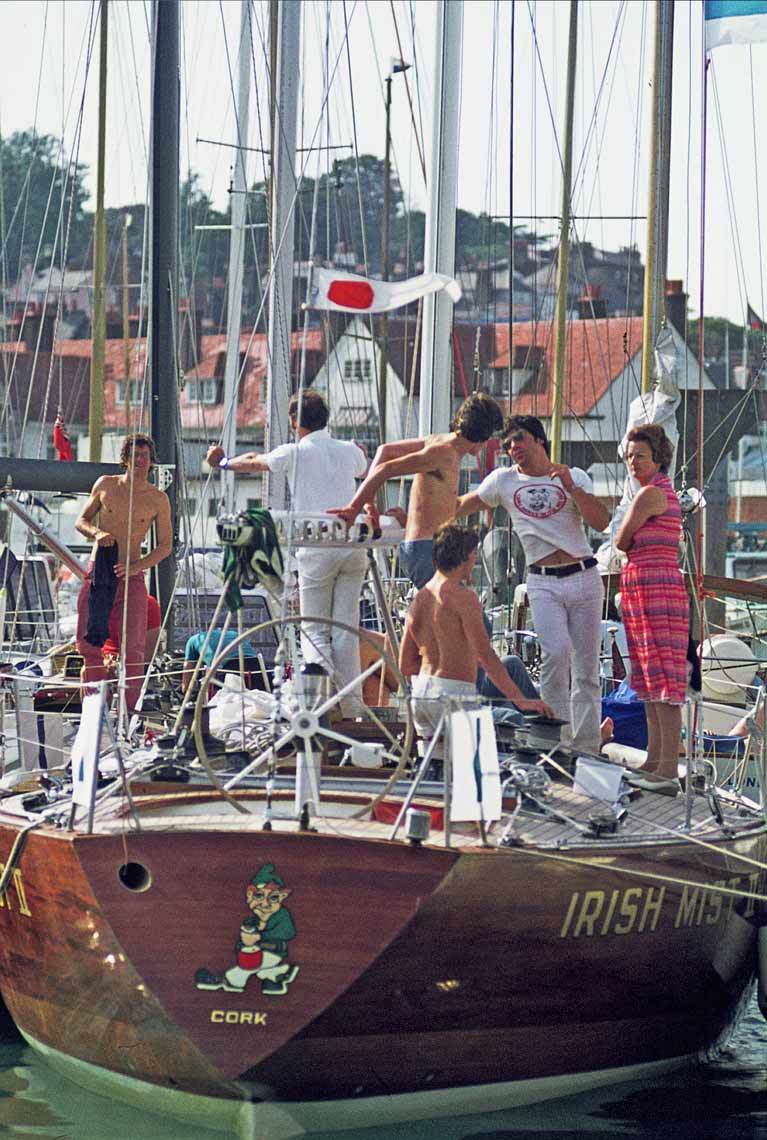 A hugely successful Ron Holland design of 1974, Archie O’Leary’s 40ft Irish Mist II - which was built in Cork by George and Killian Bushe - had a classic pintail stern. Photo: Ray Hoare
A hugely successful Ron Holland design of 1974, Archie O’Leary’s 40ft Irish Mist II - which was built in Cork by George and Killian Bushe - had a classic pintail stern. Photo: Ray Hoare
The whole place fairly crackles with ideas and innovation, but the idea of having Imp back in pristine order in time for the Royal Cork Tricentenary is something which can be shared by off-the-wall thinkers and conservation-minded historians with equal enthusiasm.
Her first owner Dave Allen of San Francisco was already in the limelight for his very purposeful Gary Mull-designed Improbable, which was so fast off the wind that few people saw her – she was already gone.
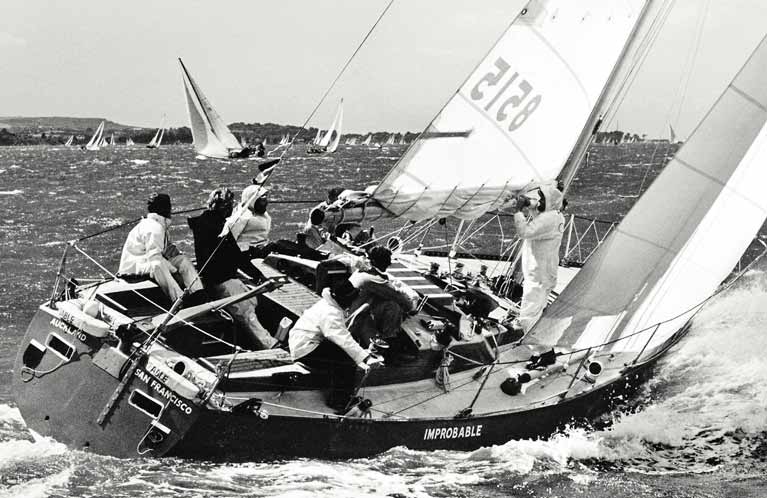 Dave Allen’s previous boat, the Gary Mull-designed Improbable, was a flying machine offwind with a ginormous tiller to control her, but not so good at the uphill stuff
Dave Allen’s previous boat, the Gary Mull-designed Improbable, was a flying machine offwind with a ginormous tiller to control her, but not so good at the uphill stuff
But he wanted a boat which provided better upwind performance too, while avoiding the narrow-sterned IOR boats which were dominating the scene at the time. So Ron Holland produced the design (despite being decidedly over-worked at the time) and Gary Carlin built her in Florida around an alloy tubing structure which was so effective that it was said the hyper-light glassfibre hull “was only there to keep the water out…..”
Her string of main successes we’ve already listed, but it’s the fond and favourable emotions which the very mention of Imp has evoked which have been truly startling. For sure, there’s boats. There’s great boats. And then there’s Imp.
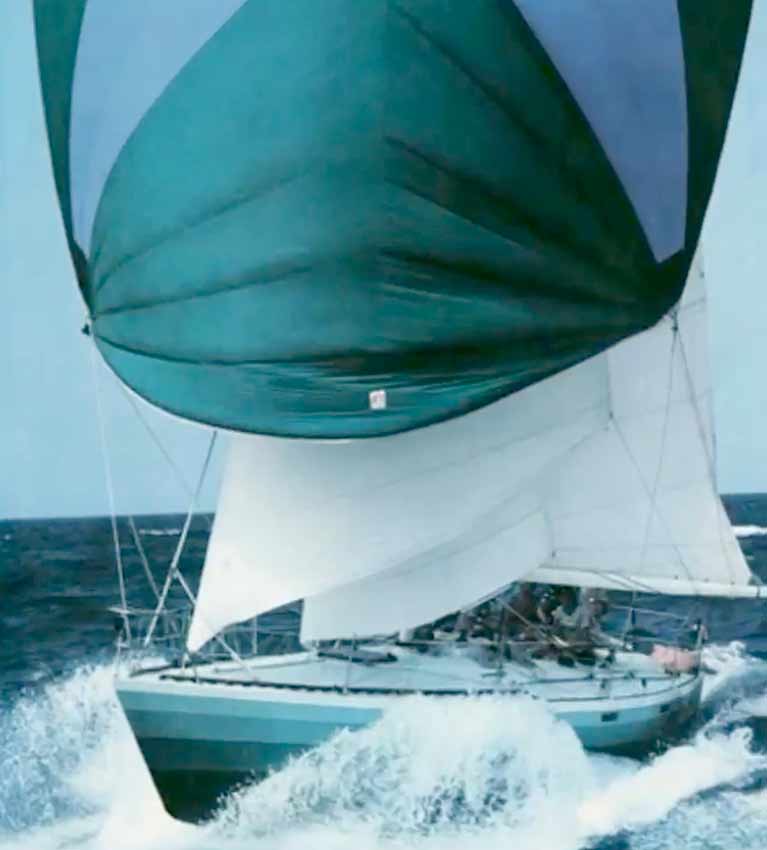 A flying machine on every point of sailing - Imp makes her debut in the Miami-Nassau Race 1977
A flying machine on every point of sailing - Imp makes her debut in the Miami-Nassau Race 1977
Imp is Coming Home to Cork Harbour
It says everything about the legendary allure of the 1976 Ron Holland 40-footer Imp that we only have to run a headline saying Imp is coming home for most sailors in Ireland to have some idea of what it’s all about writes W M Nixon
And it tells us more about the boat’s association with us all that we should talk about her “coming home” when much of her star status was achieved under the first ownership of Dave Allen of San Francisco, while the boat was actually built in Florida in by the designer’s then brother-in-law Gary Carlin.
The 1970s were the very special time for Ron Holland designs, created in the Strand Farmhouse in Currabinny across from the Royal Cork Yacht Club, and then in more spacious premises in Kinsale. His boats won the Quarter Ton World Cup and the Half Ton World Cup, and were always in the frame in the One Ton Cup, while in the Admirals Cup series at its peak there were more Holland boats than those from any other designer.
But with the International Offshore Rule dominating boat shapes, in the mid-’70s the hulls were becoming rather extreme, with narrow pintail sterns. Imp was one of the boats which began the move away from this increasingly unhealthy form, with a wider stern at the owner’s insistence to improve her offwind performance. Yet to Ron Holland’s satisfaction, not only was she significantly faster offwind than comparable boats of the pintail type, but he and his design team had hit on a hull form which was still providing a prodigious upwind performance.
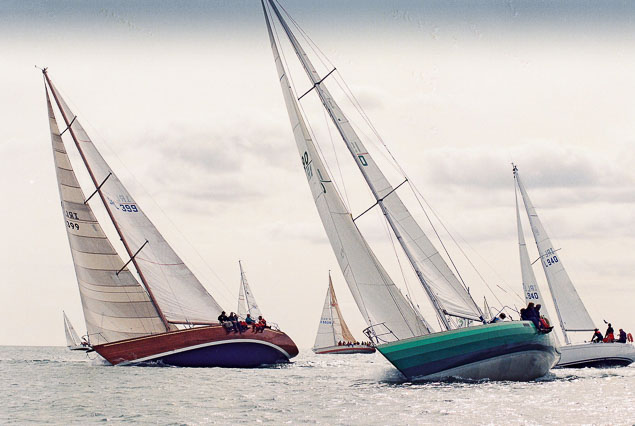 God be with the days…..even Denis Doyle’s Moonduster sometimes found herself astern of Imp. Photo: Robert Bateman
God be with the days…..even Denis Doyle’s Moonduster sometimes found herself astern of Imp. Photo: Robert Bateman
In fact Imp – which had been built as light and austere as possible around an alloy tubing framework – was a star turn on every point of sailing, and when she came to Europe in 1977, she won the Fastnet Race overall, which was one extraordinary feather in Ron Holland’s cap, as his Nicholson 33 design Golden Delicious had been overall winner in an admittedly flukey race in 1975.
But Imp’s 1977 win of the big one against a fleet of 284 boats was straight up brilliance, and the boat with her startling green stripe livery became probably the best-known racing yacht in the world. She was back for the 1979 Fastnet, but in that storm-battered event, while she did finish well up the rankings, it was Ted Turner who won overall with ferocious hard-driving of his S&S 63 Tenacious.
However, Imp stayed on in Europe, and very soon she was Irish-owned. She was a wonderfully well-mannered yet potent boat to race. But there were no excuses for not doing well with this proven machine, while she offered only very Spartan accommodation for anyone who had a notion for a spot of family cruising as well.
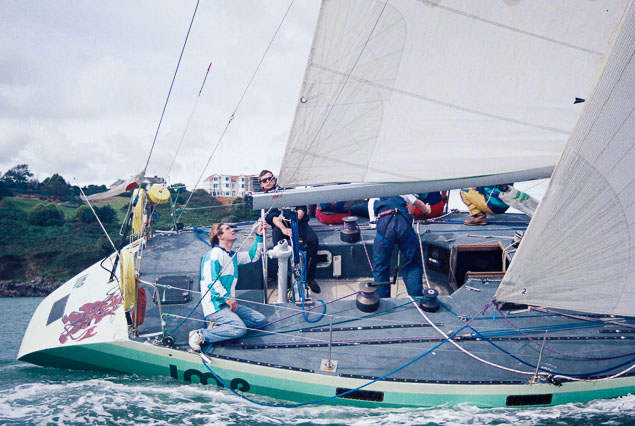 Everyone’s abiding memory of Imp is how much fun she was to race…..and winning a lot of the time helped too. Photo: Robert Bateman
Everyone’s abiding memory of Imp is how much fun she was to race…..and winning a lot of the time helped too. Photo: Robert Bateman
Thus Irish ownerships of Imp tended to be relatively brief, and involved such noted Dun Laoghaire names as the Sisk brothers and Michael O’Leary (the sailing one, not the airline guy). They continued to ratchet up success, and by 1987 she was in the ownership of Roy Dickson of Howth who – ten years after Imp’s successful Fastnet debut – showed there was still life in the old girl by winning the Philip Whitehead Cup in the 1987 Fastnet.
After that, she was sold to Carrickfergus owner Roy Hamilton and was notching appearances in other venues, but before long she was headed south again to the ownership of George Radley Jnr of Cobh, who won the 2000 Round Ireland race with her, and very nearly won the 2002 Round Ireland as well, only to have victory snatched away by fellow Cork Harbour sailor Eric Lisson with Cavatina in the final hours.
Imp continues in George Radley’s ownership, but she has been away from Ireland for quite some time now, with a Transatlantic passage and more recently a sojourn in eastern England seeing about having the major refit she so rightly deserves.
But now, with keel removed and mast piled on deck, she has been seen on a low loader headed back from England for Ireland, and a major refit at George’s own private boatyard beside his house on the north shore of Great Island in Cork Harbour. The word is that she will be in pristine condition for the Royal Cork YC’s Tricentenary highlights in 2020. With Imp very much present in her restored glory, this will be turbo-charged sailing history brought vividly to life and then some.
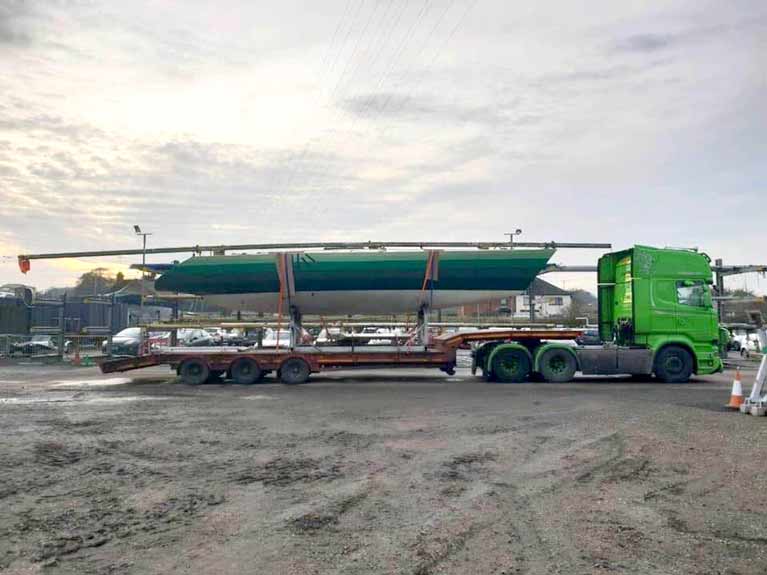 The mighty green wonder – her keel removed for transit – ready to hit the trail back to Ireland for a major refit beside Cork Harbour Photo: Facebook
The mighty green wonder – her keel removed for transit – ready to hit the trail back to Ireland for a major refit beside Cork Harbour Photo: Facebook


























